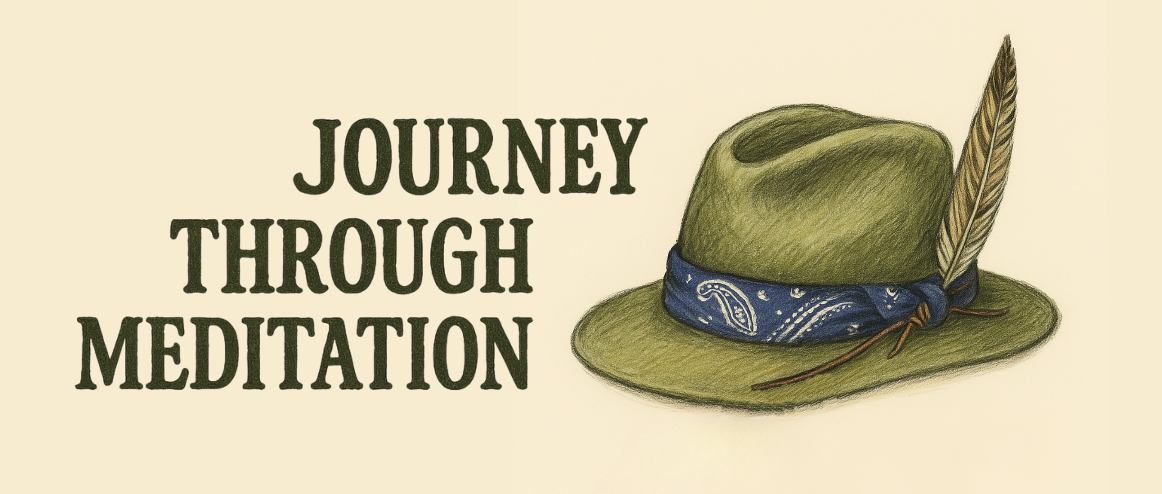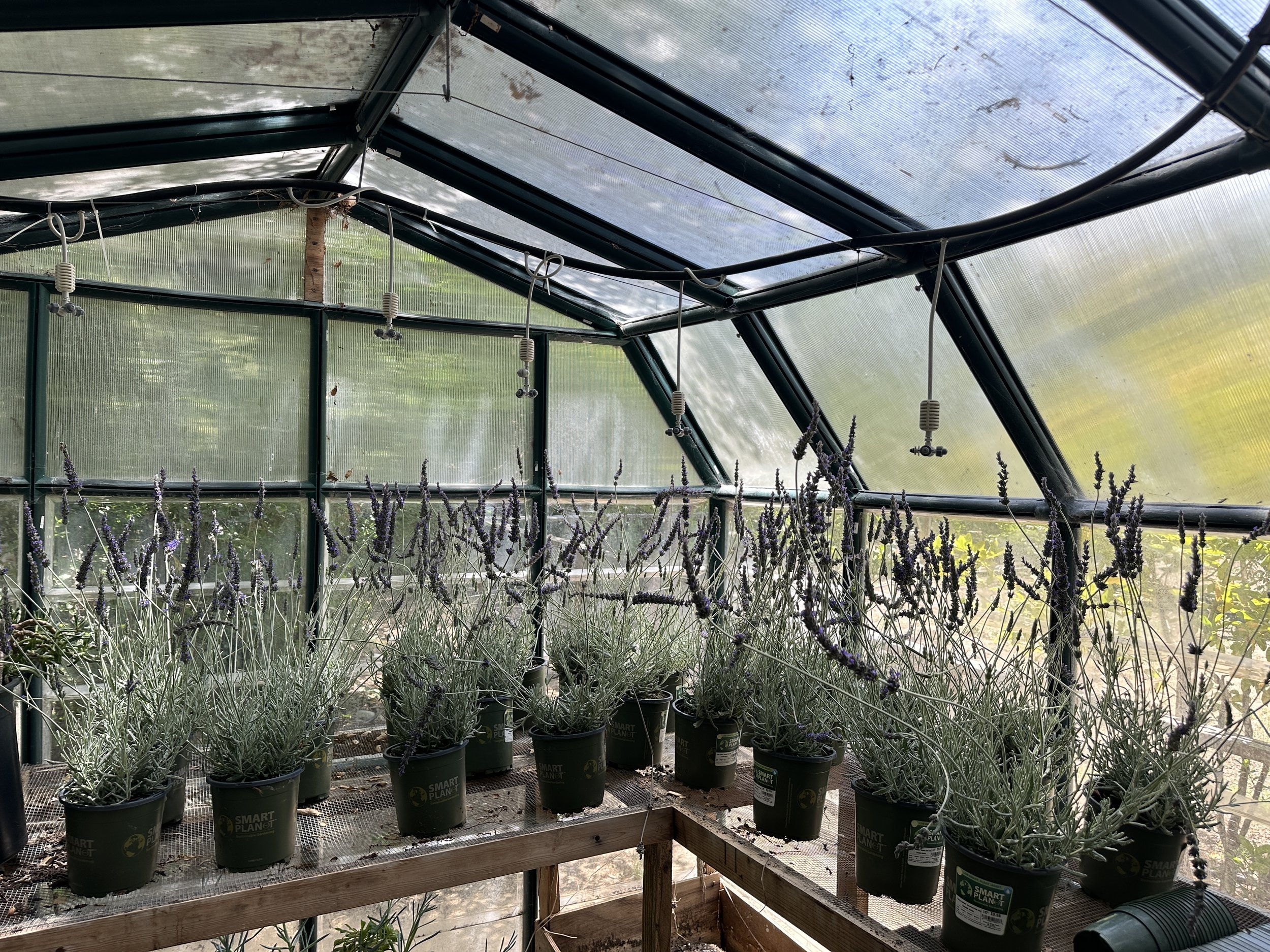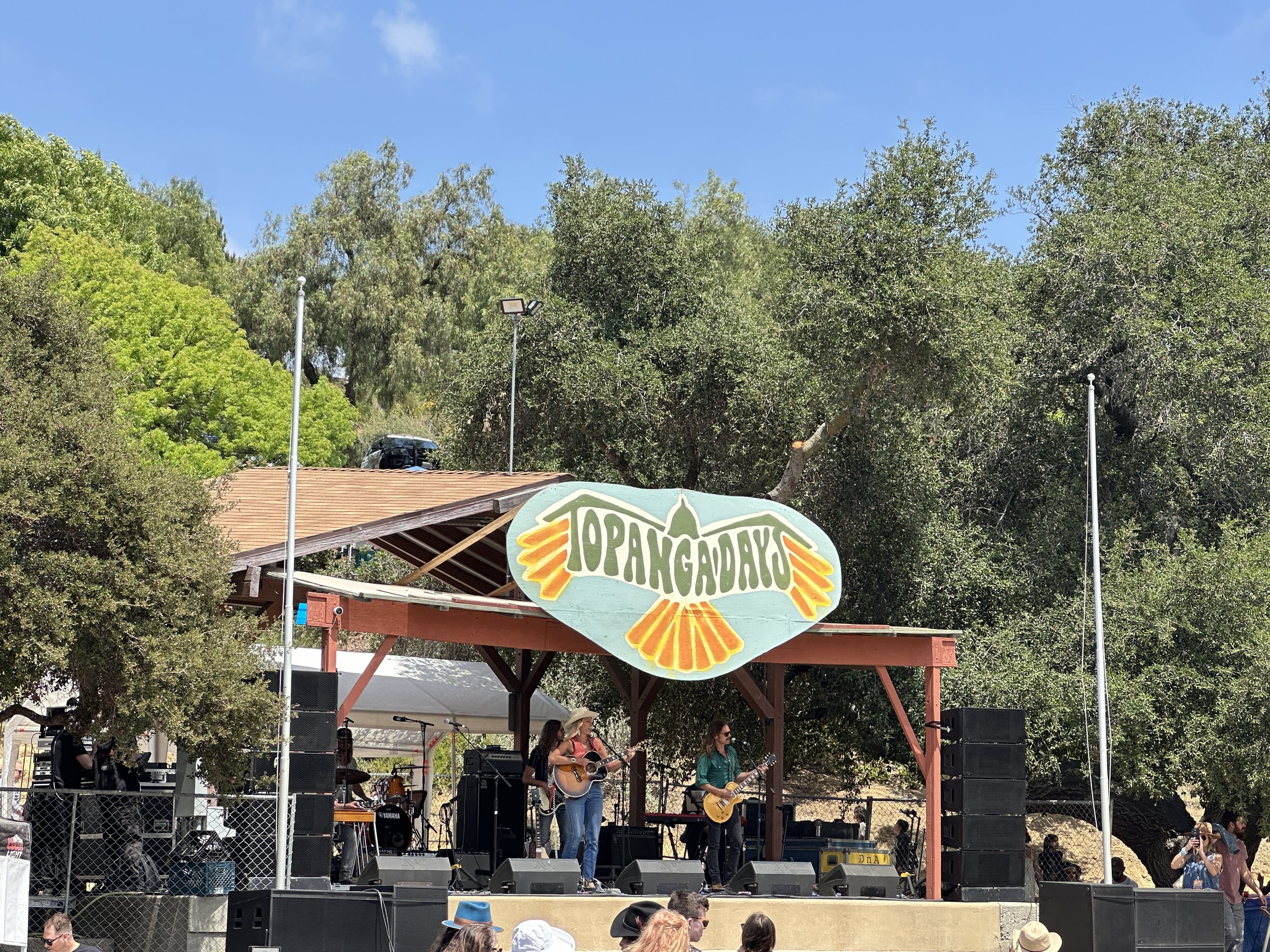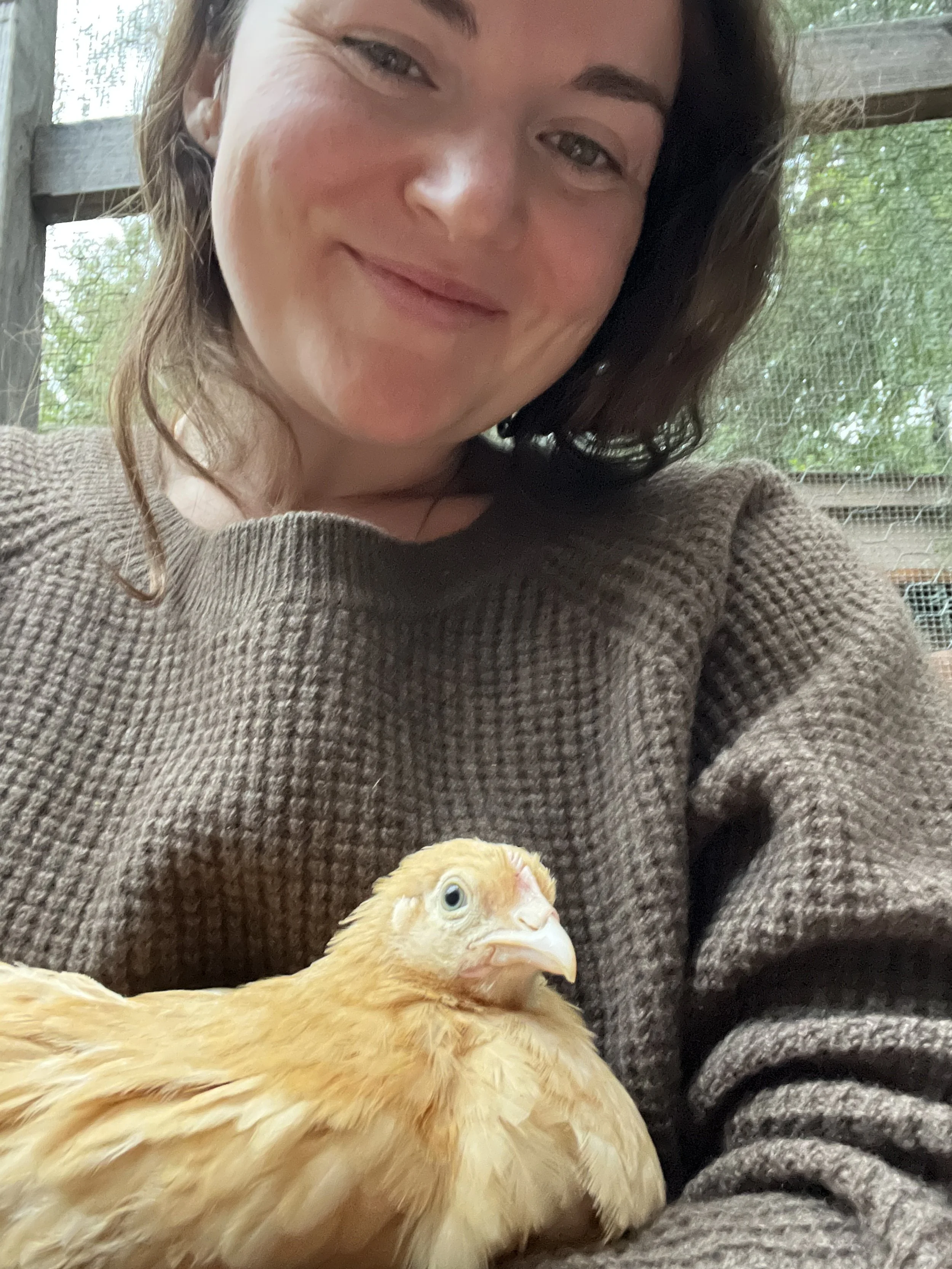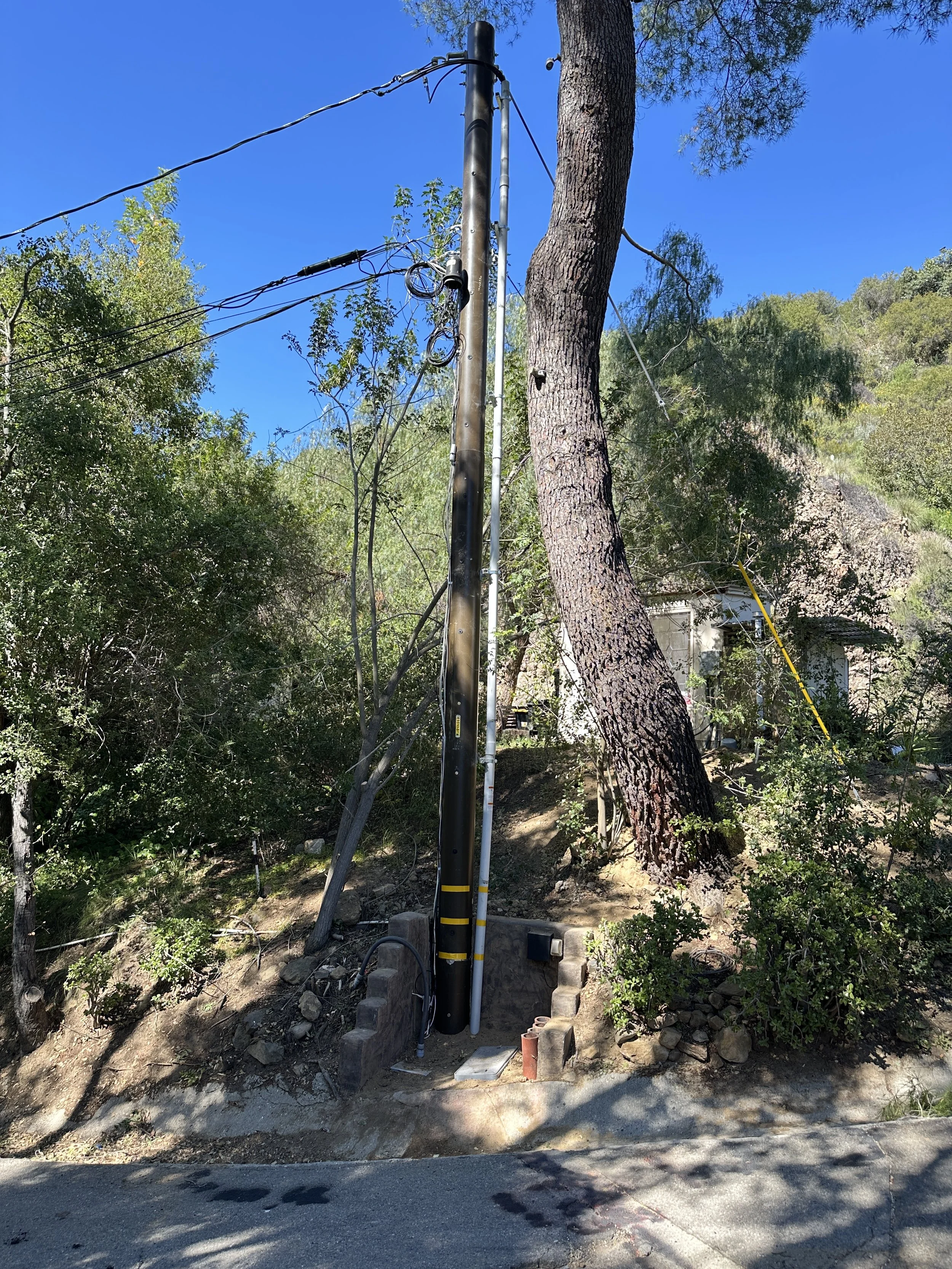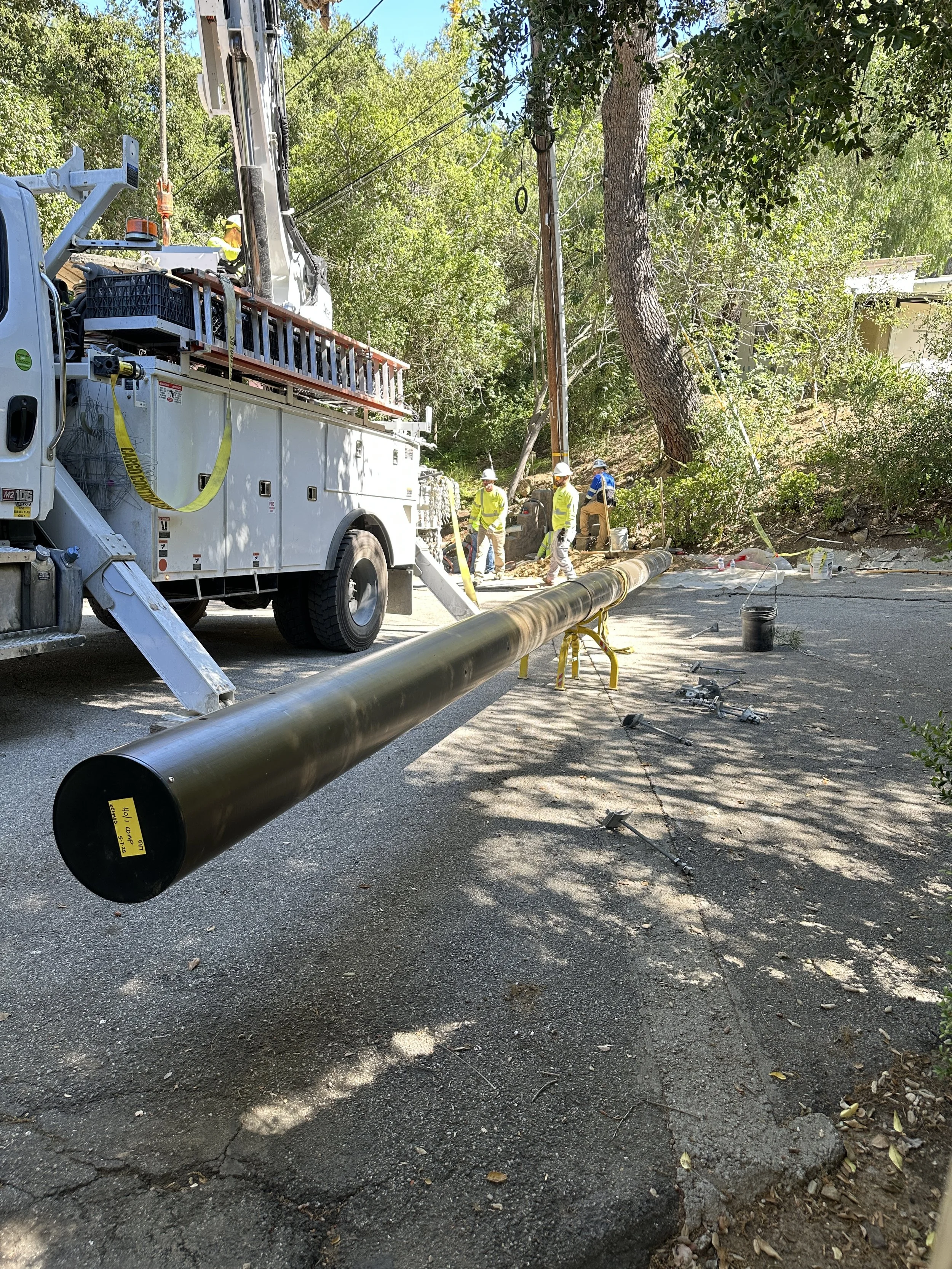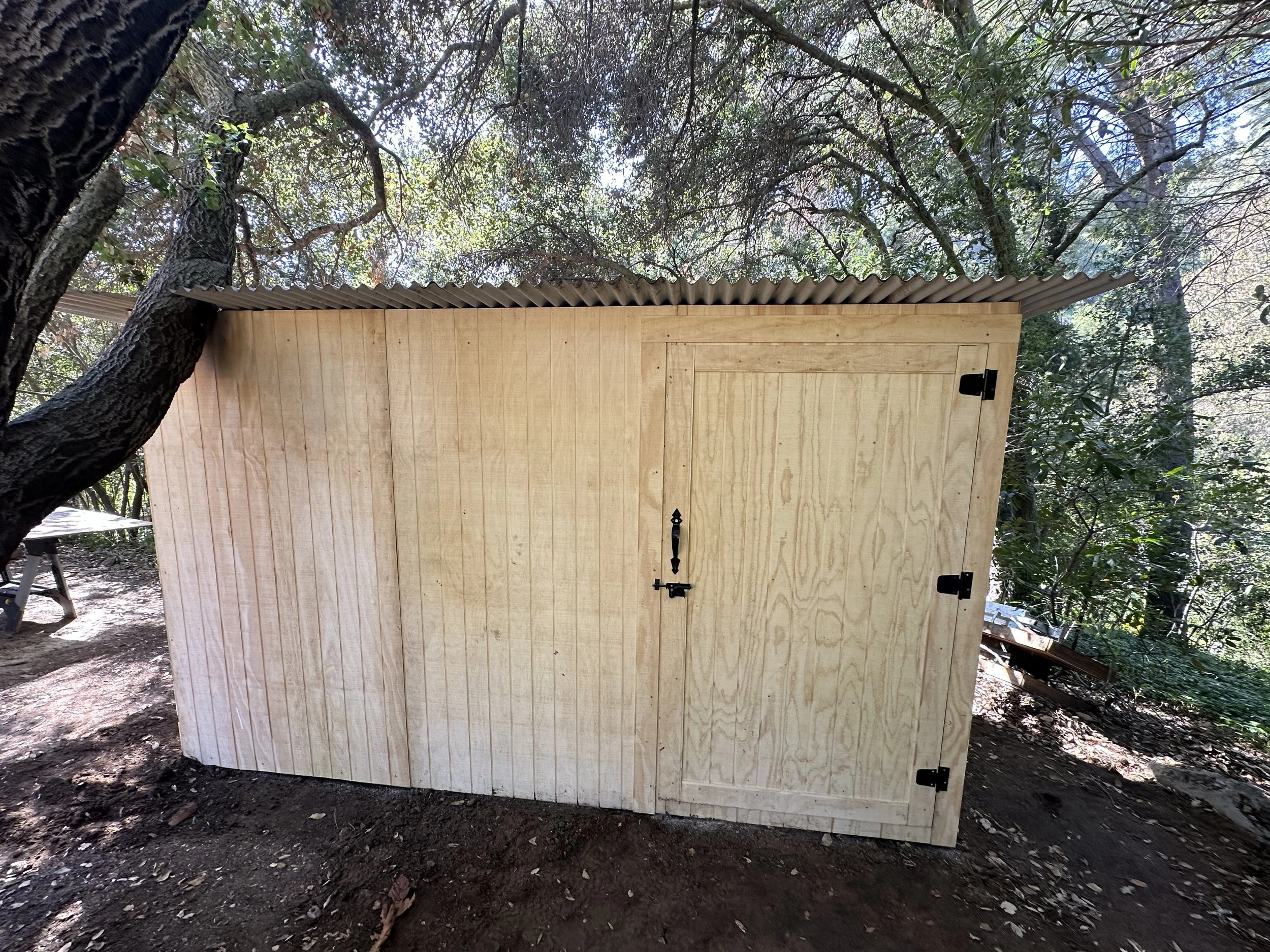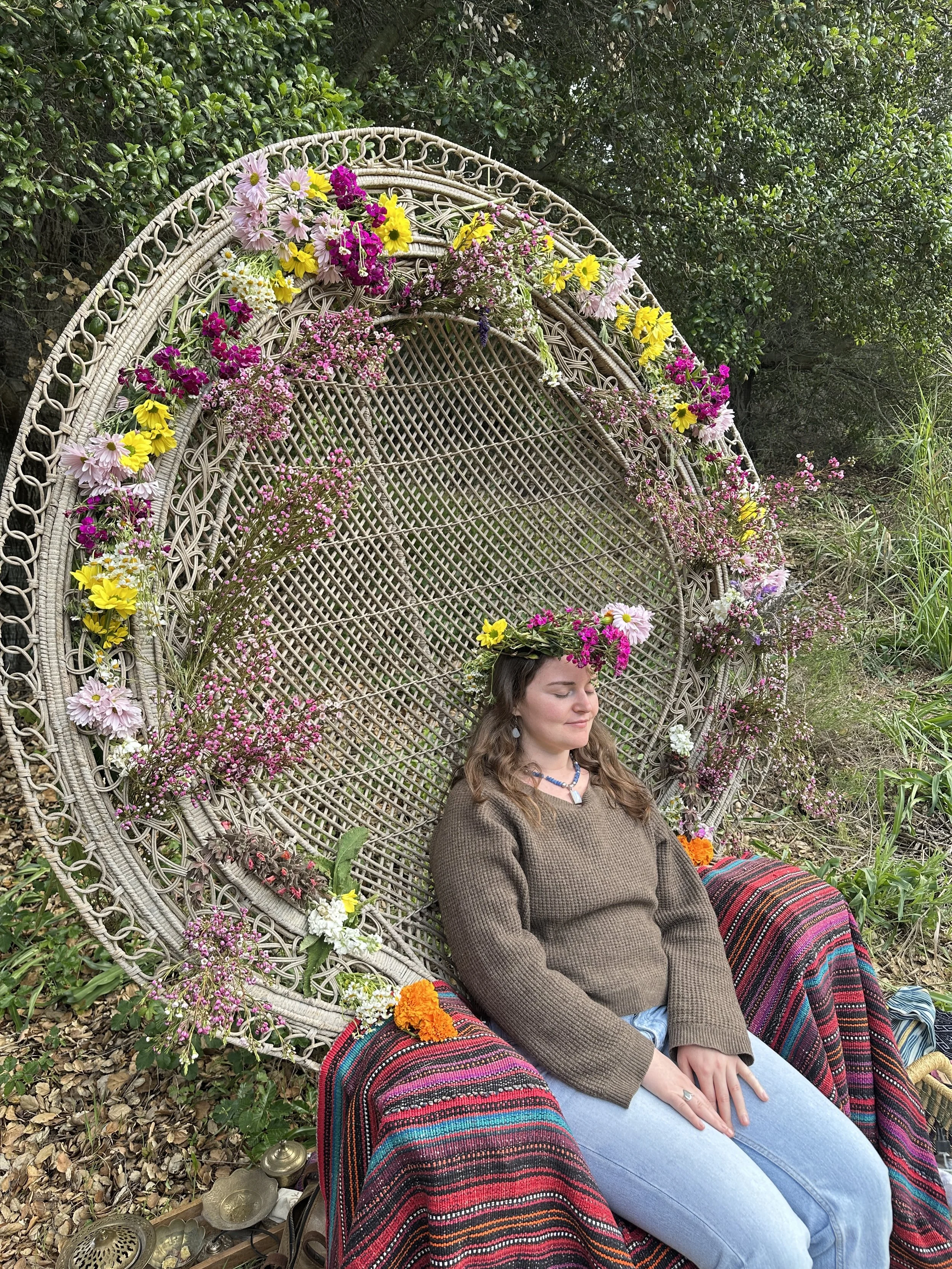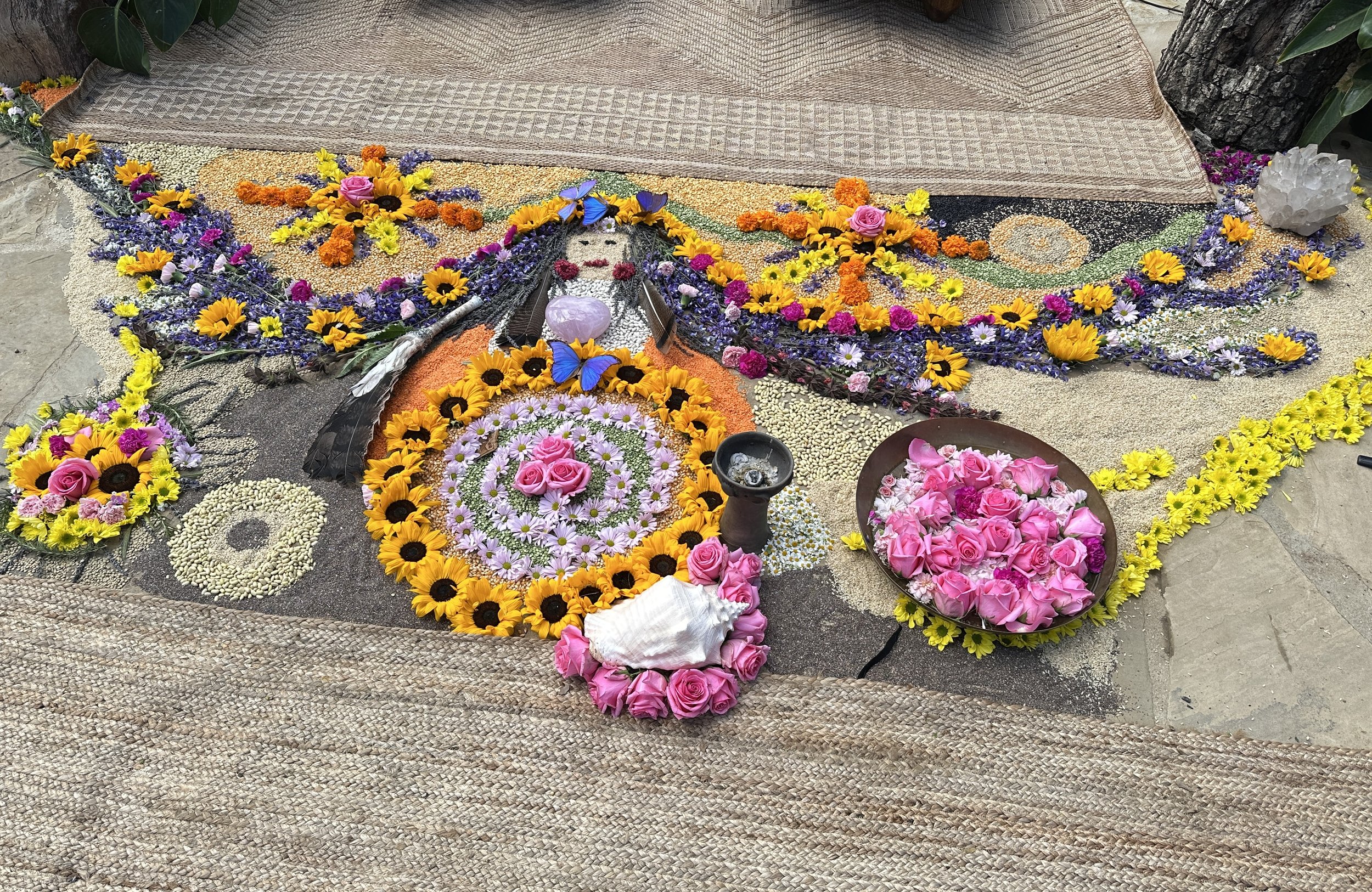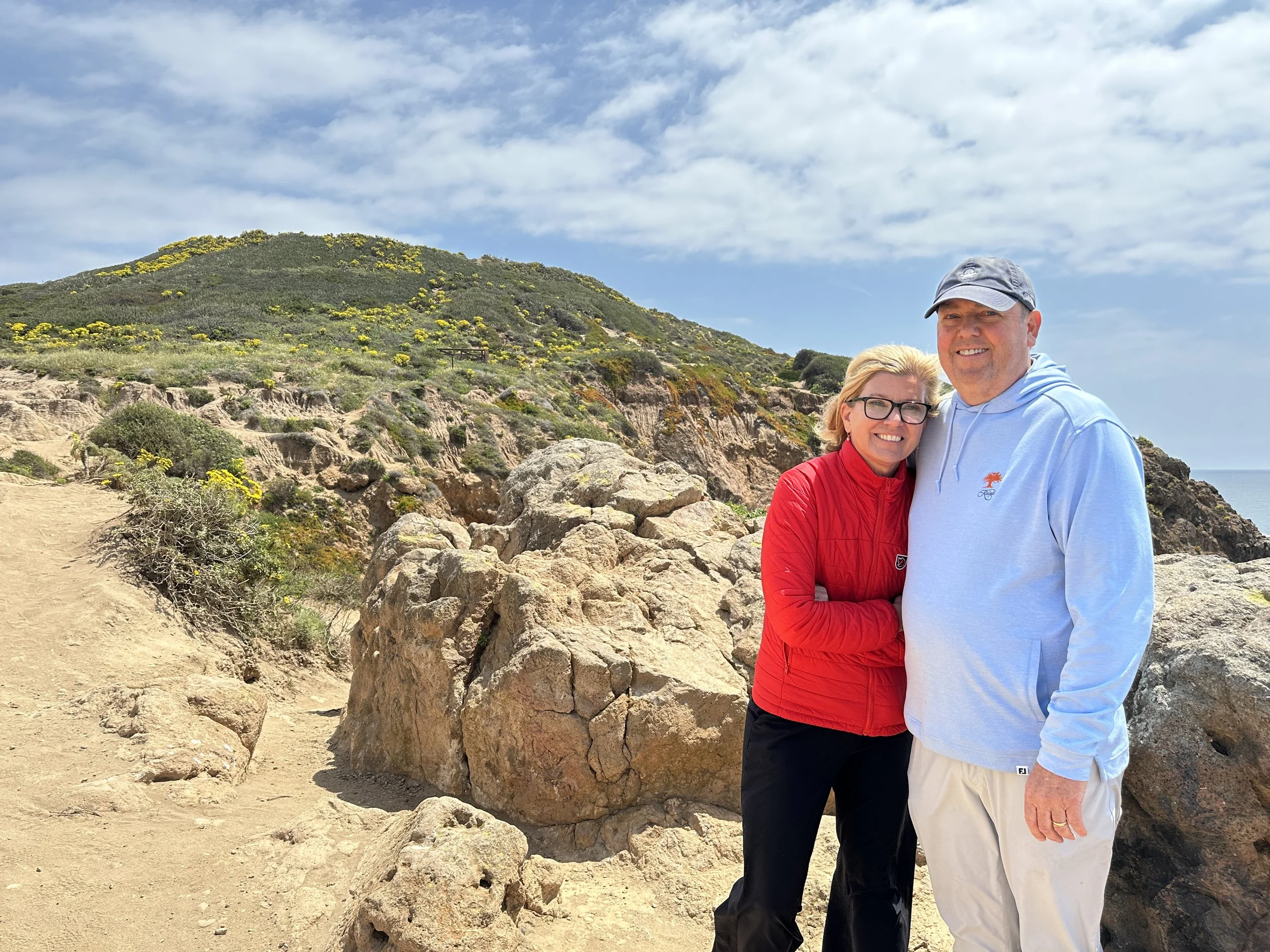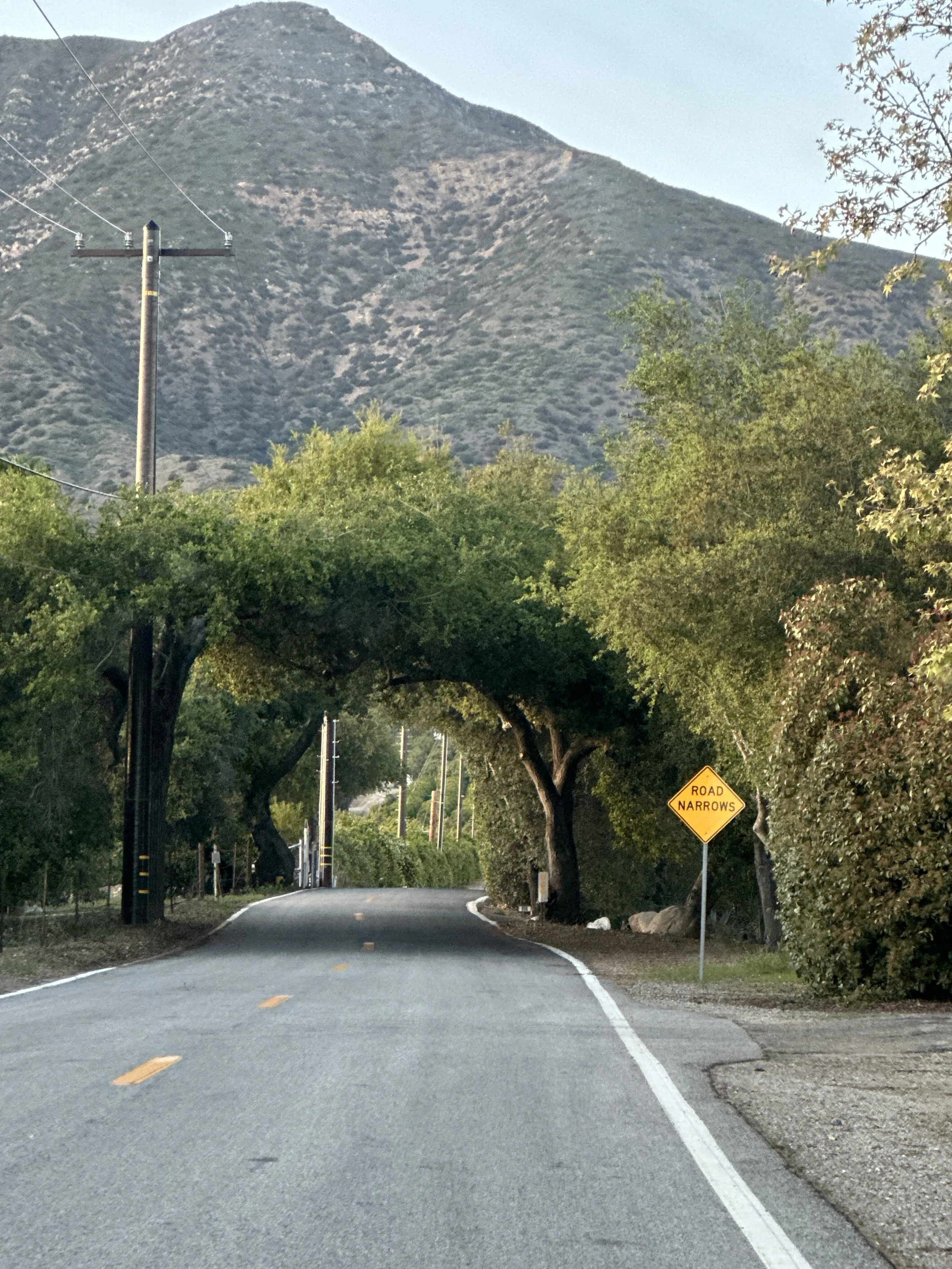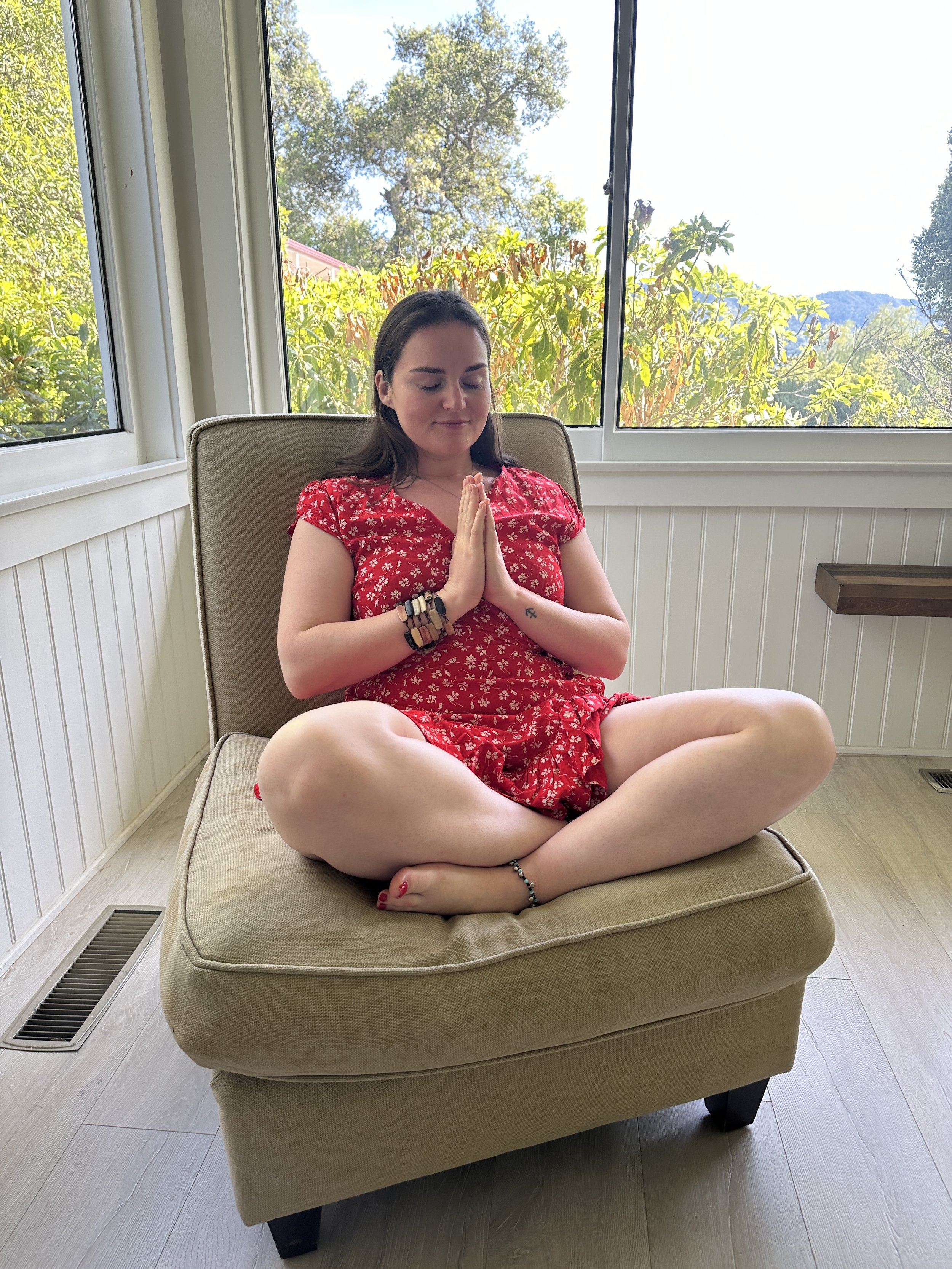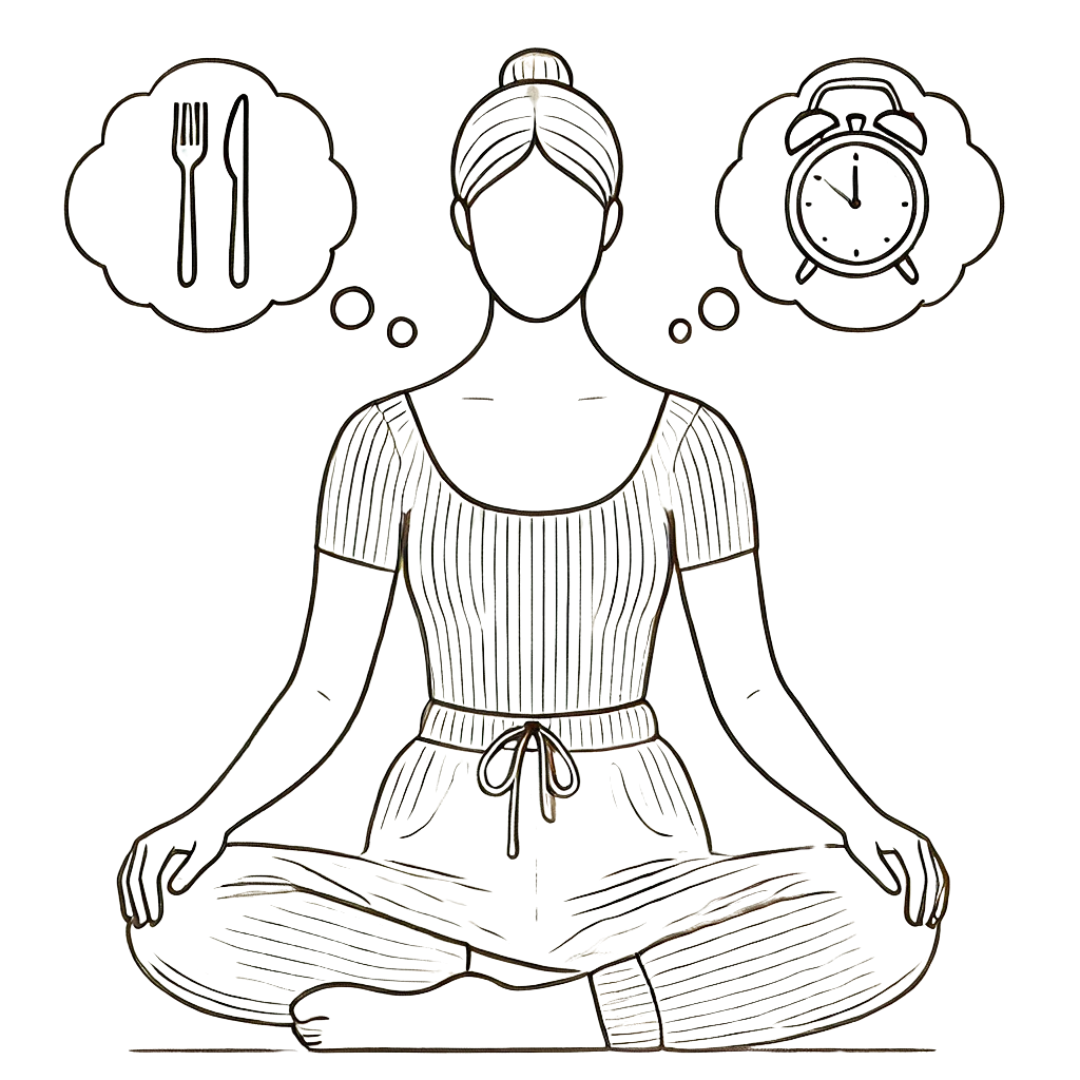Your Custom Text Here
Planting Lavender: Cultivating Calm, One Root at a Time
Over Memorial Day weekend, I planted two dozen lavender plants along the orchard path at our Topanga retreat center. In this post, I share why we chose lavender, how i planted it, how we’re caring for it, and how it ties into our daily meditation practice, herbal wellness routines, and plans for the retreat property.
Over Memorial Day weekend, Home Depot had a big sale—and I came home with two dozen lavender plants, each at half price. It felt like a little gift from the universe, arriving right when I’d been imagining ways to bring more beauty and tranquility to the property. Ever since Katy and I visited Butterfly Mountain—a retreat center with walking paths lined in full-grown lavender—I’d been inspired to do the same here. There’s something about that burst of purple, the soft hum of bees, and the scent in the air that instantly soothes the soul.
I kept the plants in our greenhouse for a few weeks while I worked on prepping the land. Then, finally, I had time to plant. I chose the path that winds through the orchard—connecting the middle and upper parts of the property. It’s a transitional space, and I loved the idea of giving it more life and presence.
Lavender as a Spiritual Ally
Lavender may be beautiful, but its meaning runs deeper than appearance. Spiritually, it’s often associated with purification, devotion, and healing. Known for its calming properties, it supports the nervous system and promotes peace, both physically and energetically. You can burn it as an incense or diffuse its essential oils before meditation to clear stagnant energy and soften the mind.
There’s something poetic about using lavender to line a pathway. Like a gentle guardian, it ushers you from one place to another. Whether guests are walking that path with a cup of tea or returning from a workshop in silence, I hope they feel a shift, however subtle.
The Meditation of Planting
Planting lavender under the sun became its own kind of meditation. There’s a presence required—digging the hole to just the right depth, feeling the roots, gently shaking off excess soil, covering the base again with care. I could feel the shift in my attention as I worked: no screen, no to-do list, just this lavender and this earth.
It’s a full-body meditation, activating nearly all your senses. The color pulls your eyes toward it, the fragrance is immediate and relaxing, the soil cool in your palms, and the bees weaving in and out of the plants. When you slow down like that, nature opens up a little more.
Shared Vision, Shared Rituals
Later, Katy joined me by the path. She crouched down to smell the leaves and lit up with ideas. Lavender is a staple in any herbalism practice, and she immediately started imagining all the ways she could use it: infusing oils for massage, crafting herbal sachets, distilling small batches of essential oil. She talked about making tea blends to serve during retreats, a simple offering guests could sip on while arriving or winding down.
That moment reminded me how much of this land we’re building together. The work we put in is not just for us—it’s for the people who come here, the practices we’re nurturing, and the calm we want to extend to others.
Faith in Time
Lavender can be tricky to establish. It needs good sun, drainage, and careful watering in the early stages—but once it takes root, it’s strong and drought-tolerant. In a way, it mirrors the meditation practice itself. At first, it’s fragile. You have to show up every day. Tend to it. Be patient.
When we plant, we’re placing faith in time. We’re trusting the earth, the sun, and ourselves to keep showing up. Just like meditation, the benefits aren’t always immediate—but with patience and care, they bloom.
And even if I don’t get to see these plants at their peak—because who knows what changes might come down the line—it still feels right to plant them. Someone planted the cacti, the oaks, the fruit trees I now enjoy. This is my offering in return.
Starting a 4:30 AM Routine: Why We’re Rising Before the Sun
This week, Katy and I embarked on something ambitious: waking up at 4:30 am to start a brand-new morning routine. Our goal? To carve out dedicated time for contrast therapy (sauna and cold plunge) and yoga before the rest of the day unfolds.
This week, Katy and I embarked on something ambitious: waking up at 4:30 am to start a brand-new morning routine. Our goal? To carve out dedicated time for contrast therapy (sauna and cold plunge) and yoga before the rest of the day unfolds.
Even though we live right here at the retreat center—with access to amenities many would dream of—our days are anything but predictable. Our work schedules change weekly, retreat events take over shared spaces, and by the time the sun sets, I’m usually too exhausted from a full day of landscaping, maintenance, and traversing these ten rugged acres to even think about unrolling a yoga mat.
After weeks of missing practices we deeply value, we finally realized that early morning was the only consistent time we could count on. If we wanted these rituals in our lives, we’d need to beat the sun.
Laying the Foundation
Fortunately, I already had a habit of waking at 5:45 am for my daily market write-ups. So pushing that to 4:30 am felt challenging but doable. But as any good early riser knows, mornings begin the night before.
At 8:00 pm, we start winding down. The chickens help keep us honest here—by sunset, they naturally head into their coop. These days, chicken bedtime = our bedtime. By 8:30, we’re usually tucked in with enough time for a solid 8 hours.
Our 4:30 AM Routine
4:30 am – Alarm rings. We throw on some layers, grab our bags, and hike up the hillside path to the sauna area.
4:45 am – We fire up the sauna and plug in the cold plunge. We’ve prepped the space the night before with towels, oils, and water jugs so it’s all ready.
5:00–5:45 am – We alternate between hot and cold: 10 minutes in the sauna, rinse and plunge, repeat. It’s intense—but you’ll never need coffee again.
5:45 am – Outdoor shower time.
6:00 am – I’m at my laptop posting my daily market report. Katy preps oats in the Instant Pot and lets the chickens out to greet the day.
6:15 am – We walk up to the yoga studio.
6:20–7:00 am – Our yoga practice begins. I lean Ashtanga; Katy often prefers yin. We meet again in stillness, lying in shavasana beneath the soft light of early morning.
A Different Kind of Productivity
By 7:00 am, we’re centered and ready for the day. It’s remarkable how much easier everything feels when the morning begins with intention. I head into another full day managing the property, while Katy heads off to offer massage treatments at the spa.
We’ve only completed this new rhythm for two days so far—but it already feels like a game changer. I’ve built a strong habit of early rising before, and I believe we can sustain this one, too.
Practices like sauna, cold plunge, and yoga nourish the body—and also feed our spirits. Waking up this early reminds me: if something matters, make space for it—preferably before everyone else gets busy.
The Spirit of Place: Meditation and Celebration at Topanga Day
Topanga Days is the canyon’s most spirited annual celebration—a music festival and parade that bring the whole community together in color and motion. In this journal entry, I reflect on how Katy and I found presence in the middle of it all—through music, movement, and moments of quiet awareness woven into celebration.
This past weekend was Topanga Days—the biggest event of the year in our canyon. It's one of those moments when the community pours itself into celebration, and the whole town shows up in color. Katy and I went to both parts of the festivities: the music festival on Saturday and the Memorial Day parade on Monday. Together, they offered not only great fun, but also an unexpected opportunity to tune into the unique spirit of this place.
Field Notes from the Music Festival
The festival grounds were set beneath the local community center field, surrounded by characteristic breathtaking view of the canyon. Vendors circled the field, food trucks filled the air with spices and sizzle, and bands played back-to-back on the main stage. Katy and I brought a blanket, found an empty spot in the middle of the crowd, and laid back to listen.
There’s something grounding about lying on the earth with music moving through the air. At one point during a performance by Spazamatics, I closed my eyes and let the bass move through me. It became a kind of sound meditation—breathing in rhythm, feeling the beat settle into my chest. Sometimes in meditation, we sit in silence to find presence. But here, in the middle of a music festival, I found that same quiet inside a storm of sound.
We wandered a bit too—watching the sack race (a favorite), browsing handmade goods, and people-watching. There’s a playful innocence to seeing adults fall over in burlap sacks or kids dancing in the dust. It reminded me how joy can be a practice too.
The Parade: Color, Culture, and Community
On Monday, the canyon gathered again for the Memorial Day parade. Topanga Canyon Blvd. filled with classic cars, floats, motorcycles, horses, bicycles, and scooters of every kind. People dressed up in costumes, threw candy to kids, waved flags, and leaned out of windows shouting greetings. There were bubbles, banners, tutus, capes, and an unmistakable flare that could only be described as Topanga.







What I loved most was how every float felt personal—homemade, heart-filled. It was DIY culture at its most sincere. You could see the effort, the family collaborations, the inside jokes that only canyon locals would understand. In a world that often feels so curated and polished, this felt refreshingly real.
And even in the excitement, there was room for mindfulness. As the parade passed by, I practiced a kind of moving meditation—watching each moment arise and fade: a marching band, then a man on stilts, then a dog in costume. Just like thoughts. Just like clouds.
When Presence Meets Place
Topanga Days is loud and colorful and celebratory—but beneath the surface, it’s also an invitation. To notice. To witness a place revealing itself through its people. To remember that even joy, even community, can be a form of practice.
Feathered Friends and Buzzing Blessings: New Life at the Retreat
This week, our retreat center welcomed four new chickens and a collection of honeybee hives. After weeks of preparation—clearing space, safeguarding the coop, painting, and placing crystals—our hens have arrived, each with a name and personality. Alongside them, a local beekeeper introduced buzzing hives to the hills. This journal entry reflects on the meditative power of caretaking, and how sometimes, the most spiritual moments come with feathers and wings.
There’s something sacred about welcoming animals onto the land. This past week, Katy and I introduced four new chickens to the retreat center, and I can honestly say—my heart is full. After weeks of preparation, cleanup, construction, painting, safeguarding, and dreaming... our little flock has finally arrived.
We’d been eyeing the empty chicken coop near the garden for a while. It had potential, but the surrounding area had become cluttered with tools, wood, and stray supplies. In a burst of motivation, I spent the past month transforming the space. We built two new sheds to neatly store all the tools, cleared debris, built a rack for spare wood and ladders, and gave the coop a new coat of paint. We even placed crystals in each of the chickens’ nesting boxes—hoping to bless them with calm energy and future fertility.
In many spiritual traditions, preparation is its own form of meditation. Whether you’re sweeping a temple floor or scrubbing down a chicken coop, there’s a mindfulness that comes from working with your hands. Just as a meditator returns to their breath, I found myself returning again and again to the details—fixing the latches, adding predator guards, screening the windows, walking the perimeter like a gentle sentry. There’s a spiritual satisfaction in making something safe, something sacred, something that says: “You are welcome here.”
Our four new hens were delivered by a woman from Backyard Chickies, who drove all the way up from San Diego and arrived after dark. She was calm, confident, and clearly experienced—at one point, she scooped all four chickens into her arms and gently lowered them into their new home. It felt ceremonial, in a way. We stood in the glow of the lamp light, quietly watching as the chickens settled into their coop for the first time.
Meet the Flock
Each of our hens has a name and a growing personality:
Silkie – Named after her breed, she’s as soft and cuddly as a plush toy. Gentle, affectionate, and easy to hold.
Goldie – A Buff Orpington with a calm demeanor and warm golden feathers. She’s our golden-hearted egg-layer in training.
Bluebell – A speedy little Ameraucana who lays blue eggs (eventually!) and is often the last one we catch at bedtime.
Rockstar – Our Cream Brabanter with wild, feathered hair and a big presence. The largest of the bunch and full of flair.
Right now, the chickens are still young—just 8 to 12 weeks old—so no eggs just yet.
But every morning at dawn, we open their coop and watch them explore the enclosure. Every evening at dusk, we coax them back in (sometimes with great effort!). Eventually, they’ll put themselves to bed. Until then, it’s a gentle routine—one that’s grounding, humorous, and honestly, really heartwarming.
Buzzing Into Balance
As if that weren’t enough new life for one week, bees also arrived on the land.
A local beekeeper, Eli’s Bees, came by to drop off pallets of buzzing bee boxes. He’ll be cultivating hives here on the property and harvesting honey, some of which will eventually be sold in the retreat’s gift shop.
There’s something beautiful about this layering of life—hens in the garden, bees in the hills, all moving together in rhythm. The chickens remind us to slow down, to stay grounded. The bees remind us to work in harmony, to serve something larger than ourselves. Together, they feel like tiny guides—each offering a different flavor of presence.
Meditating with the Seasons: How to Shift Your Practice with Nature’s Rhythms
Nature moves in cycles—and your meditation practice can too. In this post, explore how to align your meditation with the rhythm of the seasons, from spring’s renewal to winter’s deep rest. A gentle guide to making your practice feel more natural, intuitive, and alive.
Nature moves in cycles. So do we.
But in modern life, it’s easy to forget. Our calendars and screens push us to maintain the same pace year-round—always producing, always showing up the same way, no matter what’s happening in the world or within us.
But when we look outside, we remember: there are seasons for growth, for rest, for shedding, and for blooming.
Your meditation practice can honor that rhythm too.
Here’s some ways to align your meditation practice with the energy of each season—so that it nourishes you more deeply, naturally, and intuitively.
Why Tune Your Practice to the Seasons?
Meditation is about paying attention—and nature gives us a powerful template for how to do that.
By syncing your practice with the rhythm of the natural world, you can:
Stay more attuned to your body’s changing needs
Shift expectations around consistency and productivity
Deepen your connection to something larger than yourself
Bring more variety, reflection, and renewal to your practice
This isn’t about perfection. It’s about listening. Adjusting. Honoring where you are and what the earth is teaching.
Spring: Renew and Reawaken
Spring is a time of rebirth, planting, and new beginnings. The energy is upward and expansive. It’s a great time to refresh your practice or start again after a lull.
Meditation themes for spring:
Clarity
Intention-setting
Openness to change
Practices to try:
Morning meditations as the sun rises
Journaling before or after practice
Meditating outside (even for a few minutes) to feel the season's energy
Summer: Embody and Expand
Summer invites aliveness, expression, and embodiment. Energy is high. The days are long. It’s a powerful time to bring presence into the body and move your meditation into motion.
Meditation themes for summer:
Embodiment
Joy
Connection
Practices to try:
Walking or movement-based meditations
Breathwork with a focus on vitality
Practicing gratitude for warmth, light, and energy
Autumn: Reflect and Release
Autumn calls us inward. It’s a time of letting go, slowing down, and reflection. The light wanes. Leaves fall. It’s a powerful moment to assess what you’re ready to release in your own life.
Meditation themes for autumn:
Letting go
Gratitude
Acceptance
Practices to try:
Body scans with extra attention to exhalation
Visualization of releasing what's no longer needed
Journaling on internal and external transitions
Winter: Rest and Restore
Winter offers stillness, rest, and deep inner work. It may feel harder to show up—but this season invites softer practices, quiet reflection, and space for integration.
Meditation themes for winter:
Rest
Presence
Inner wisdom
Practices to try:
Evening meditations in low light
Shorter, more gentle sessions with warm tea or a blanket
Yin-based stillness and silence
The Rhythm of Nature
Just like nature, your meditation doesn’t have to look the same every day of the year.
When you align your practice with the rhythm of the seasons, it becomes more sustainable, more intuitive, and more alive. You don’t have to force stillness when your body wants movement—or push energy when your spirit needs rest.
Let the earth show you the way.
Let each season shape how you return to yourself.
Meditation Isn’t Always Calm: Why It’s Okay to Feel Uncomfortable While Practicing
Meditation isn’t always peaceful—and that’s perfectly normal. In this post, we explore why discomfort shows up in practice, how to respond to it with compassion, and why sitting with what’s hard can lead to real growth. If you’ve ever felt like you’re doing it wrong, this one’s for you.
We often picture meditation as serene: someone sitting peacefully, eyes closed, radiating calm.
But if you’ve ever actually tried meditating, you know it doesn’t always feel that way. In fact, sometimes it feels… uncomfortable. Restless. Emotional. Even frustrating.
And that’s okay.
Meditation isn’t about feeling a certain way—it’s about learning to stay with whatever is present, even when that thing is discomfort.
The Myth of Instant Calm
There’s a common misconception that meditation should always lead to stillness, relaxation, or bliss. So when you sit down to practice and instead feel anxious, agitated, bored, or tense, it’s easy to think, I’m doing it wrong.
But here’s the truth: discomfort in meditation isn’t failure—it’s part of the work.
Why Discomfort Shows Up in Meditation
When we slow down and turn inward, we’re no longer distracted by constant noise, activity, or stimulation. That means everything we’ve been avoiding—subtle anxieties, stored emotions, scattered thoughts—has space to rise to the surface.
It might feel like your mind has gotten louder, but really, you're just finally noticing the volume that was always there.
Think of meditation like a still pond: when the water settles, you start to see what’s underneath.
Types of Discomfort You Might Encounter
Physical discomfort: Tight hips, sore back, restlessness in the legs
Mental discomfort: Racing thoughts, judgment, doubt, boredom
Emotional discomfort: Sadness, anger, loneliness, fear
Each of these is valid. And each of them is worth staying with—not to fix, but to witness.
What to Do When Discomfort Arises
You don’t need to force your way through it. You don’t need to pretend it’s not there. Try these gentle approaches:
1. Acknowledge it
Label the feeling: “Tension,” “anxiety,” “fidgety.” Naming what you feel creates space and lowers reactivity.
2. Stay curious
Ask, “What is this sensation trying to tell me?” instead of “How do I get rid of this?”
3. Use the breath
Let your breath be an anchor. It doesn’t fix the discomfort, but it gives you something steady to return to.
4. Adjust if needed
Discomfort is part of meditation—but pain is not required. Shift your posture, open your eyes, or shorten your session if that helps you stay engaged.
The Hidden Gifts of Staying With Discomfort
When you learn to sit with what’s difficult—without numbing, avoiding, or judging—you build real resilience.
You discover:
That emotions are just waves, and they pass.
That discomfort can soften when met with presence.
That you’re stronger than you think, and capable of being with life exactly as it is.
This is where transformation happens—not in escaping discomfort, but in becoming less afraid of it.
Don’t be Discouraged
Meditation isn’t about controlling your experience. It’s about meeting it.
So if your practice feels uncomfortable sometimes, don’t be discouraged. That’s not a sign of failure—it’s a sign that you’re actually practicing.
Keep showing up. Not for perfection. Not for instant peace.
But to build the courage to stay present, even when it’s hard.
That’s where the real calm begins.
The Journey Through Meditation ebook offers gentle guidance, grounding prompts, and realistic tools to help you stay connected—even on difficult days. Grab a free introductory chapter here.
What Is Embodiment? How to Bring Awareness into the Body
Embodiment is the practice of bringing awareness back into the body—of feeling, sensing, and grounding yourself in the present moment. In this post, you’ll explore what embodiment really means, why it matters in meditation, and how simple daily practices can help you reconnect with yourself in a deeper, more compassionate way.
So much of modern life pulls us out of the body.
We spend hours in front of screens, move from one task to the next without pause, and often live in our heads—analyzing, planning, rehashing, scrolling. Over time, we start to feel disconnected: from our breath, from our emotions, from the present moment.
That’s where embodiment comes in.
Embodiment is the practice of coming back to your body—not just as a physical form, but as a place of wisdom, presence, and truth. It’s not something you have to earn or master. It’s something you return to.
And when you do, everything shifts.
What Is Embodiment, Really?
At its core, embodiment is about awareness of your physical experience—your sensations, your breath, your posture, your energy.
It means not just knowing something intellectually, but feeling it fully. You don’t just think “I’m anxious.” You notice the tightness in your chest, the tension in your jaw, the shallowness of your breath. You feel your state—and because of that, you can respond with care.
Embodiment reconnects the thinking mind to the living body. It roots mindfulness not just in thoughts, but in sensation.
Why Embodiment Matters in Meditation
When we sit down to meditate, it’s easy to focus entirely on the breath or try to escape into stillness. But the body is always speaking—and when we listen, our practice deepens.
Embodiment in meditation means being present with the body as it is:
Noticing where there’s tension or ease
Feeling the weight of your body against the cushion or floor
Observing the rhythm of your breath without needing to change it
Allowing emotions to arise as sensations, not just concepts
When you bring awareness into the body, meditation becomes a conversation—not just a technique.
Signs You May Be Disconnected from the Body
If embodiment feels new to you, you’re not alone. Here are some common signs that you may be operating mostly from the neck up:
Difficulty feeling emotions in a physical way
Relying heavily on thoughts to make decisions
Pushing past pain, hunger, or exhaustion
Feeling numb, spacey, or out of sync
Constantly distracted or fidgety during stillness
The good news? Awareness is the first step toward reconnection.
Simple Practices to Build Embodiment
You don’t need to overhaul your life to become more embodied. Try adding one of these practices to your day:
1. Grounding Through the Feet
Stand still for a moment and feel your feet on the ground. Notice the weight, the contact, the balance. Breathe into that connection. This can be done anywhere—waiting in line, brushing your teeth, standing on a trail.
2. Body Scan Meditation
Start at the top of your head and slowly bring awareness down through your entire body. Notice areas of tension, warmth, pressure, or numbness. Don’t try to change anything—just observe.
3. Movement with Awareness
Walk slowly, stretch, or dance while paying close attention to how each part of your body feels. Let sensation—not thoughts—guide you.
4. Breath and Sensation Pairing
During meditation, notice how your breath moves your body. Feel the expansion in your ribs, the lift in your chest, the rise and fall of your belly.
Sitting with What Is
Embodiment isn’t about perfect posture or always feeling “zen.” It’s about tuning in. It’s about learning to listen. It’s about reclaiming your body as a wise and trustworthy space to return to—especially when the mind is loud or the world feels chaotic.
When we bring awareness into the body, we find our way back to ourselves.
The Journey Through Meditation ebook includes sensory-based techniques and grounding practices to help you return to your body and build presence from the inside out. Grab a free chapter of the book here.
What Raising a Power Pole Revealed About Meditation
When a team came to replace the old electric pole at our retreat center, I watched three days of grit, humor, and coordination unfold. What started as a loud, dusty project turned into a surprising meditation on strength, alignment, and what it really takes to stay grounded.
This past week, something unexpected left a deep impression on me. Several crew of workers came to the retreat center to replace the old wooden electricity pole along the driveway—a project that unfolded over three days, right in the middle of everything.
I didn’t expect to be so moved by the process, but watching the whole thing play out—machine by machine, team by team—gave me a strange sense of awe. Not just for the technical work, but for what it revealed about structure, effort, and the deep connection between earth and energy.
Day 1: The Anchor
The first crew arrived on a Wednesday afternoon—two heavy-set, deeply grounded men with a backhoe. Their job was to plant the anchor: the metal guy wire that would keep the new pole upright and secure. They dug a hole about ten feet from where the new pole would eventually stand, right where the old anchor wire had bent awkwardly around a tree. These guys were pure earth energy. Grit under the nails. Carhartts and worn steel-toes.
At one point, they accidentally snapped an old septic pipe running under the soil. Instead of calling it a day or waiting for backup, they got creative. They scoured the property for a replacement elbow joint, and when they couldn’t find one, they heated a straight pipe in the muffler of their truck and bent it by hand. It was one of the most practical—and slightly chaotic—problem-solving efforts I’ve seen in a while.
Watching them, I couldn’t help but reflect on grounding—how in meditation we talk about "taking your seat." Just like a power pole needs a deep, secure anchor before it can rise, the mind needs its own base. For me, that includes rest, nourishing food, and connection to the body. There’s a lot of talk in spiritual circles about ascension, light, and raw food. But I find that when I’m doing physical work, like maintaining a property, I need things that root me—protein, stability, and regular sleep. The anchor comes first.
Day 2: Making Space
On Thursday, a different crew rolled in. Their job: to drill a deep, new hole for the replacement pole. While they worked, a separate team moved through the trees with chainsaws, trimming branches that threatened the lines above.
Compared to the day before, this crew was quieter. More tired, maybe. Their work was slow and repetitive—grinding into earth and concrete for hours with the drill. There wasn’t much fanfare, just the steady rhythm of making space for something new to take root.
It made me think about the phase of meditation that involves concentration of the mind. Drilling deeper and deeper through layers of distraction and uncomfortable thoughts. Sometimes, we have to do the hard work of pruning old thoughts or digging through hardened beliefs to make space for uprightness.
Day 3: Raising the Structure
The final day was a show. A larger crew—six men or more—showed up in full force. Big trucks. Loud engines. Fast movement. One truck held the new metal pole, while another handled the crane. Everyone seemed to know their role. One guy was unloading slats for the crane’s outriggers. Another was drilling into the steel. Someone else was fastening high-tension wires with practiced efficiency.
What struck me most was their synchronization. They moved like a football team in fast-forward—confident, gritty, and full of momentum. At the center was a leader: charismatic, direct, and clearly respected. At one point he shouted, “Do you need motivation or direction?” and someone yelled back, “Both!” They laughed, cracked jokes, talked about last week’s happy hour. “You were peer pressuring us!” one said. “No,” the leader said, “you were peer pressuring me!”
There was something undeniably masculine about the whole event—big trucks, steel tools, loud engines, fast decisions. Even the shape of the pole was… unmistakably phallic. But beyond the stereotypes, I saw something beautiful: real, embodied presence. They worked hard, fast, and with full attention. No one stood still. No one scrolled on their phone. They were fully in it.
When they finally lifted the pole and lowered it into the hole, I thought of the human spine in meditation. Straight, rooted, aligned. In yogic teachings, the spine is the central channel where energy flows—what some traditions call the kundalini. The pole mirrored this exactly: planted in earth, reaching toward sky, with lines running through it that would carry literal current.
Holding Steady in a Moving World
It made me think about the effort it takes to hold ourselves upright. Not just physically, but emotionally. Spiritually. What does it take to be steady in a world that’s always moving? Maybe it’s not just sitting still. Maybe it’s digging, adjusting, laughing, sweating, showing up, and making space. Maybe the pole is a reminder that the divine is grounded too—that even light runs through something solid.
Zen and the Art of Building a Shed
What began as a simple plan to build two sheds turned into a deeper reflection on mindfulness, teamwork, and the harmony between form and feeling. Inspired by Zen and the Art of Motorcycle Maintenance, this article explores the unexpected beauty of a practical project in the hills of Topanga.
There’s something unexpectedly meditative about building a shed—especially when you’re doing it on a quiet hilltop in Topanga, with birdsong in the air and tools in your hands.
Over the past two weeks, I’ve been working side by side with a couple of the grounds crew to build two new sheds for our retreat center.
The process reminded me of one of my favorite books: Zen and the Art of Motorcycle Maintenance, a philosophical classic that explores the harmony (and tension) between analytical precision and aesthetic flow.
Form Meets Function
The reason for the sheds was simple: we needed order. We needed to clean up a mess of scattered maintenance items and create a better inventory for our tools. We also wanted to tidy up the garden and orchard area surrounding the coup in preparation for the chickens we’re planning to welcome to the retreat center this spring. But the execution, of course, came with its share of complications.
The first shed
For the first shed, the complication came in the form of a row of PVC irrigation pipes, running directly beneath the site of a key posthole. It wasn’t obvious at first. We started digging and then hit plastic. Instead of shifting the shed layout (and ruining the clean rectangle we had planned), we decided to reroute the pipes entirely—cutting, adjusting with elbow joints, and tucking the system neatly out of the way. What looked like a problem turned into an opportunity to realign things in a better way.







The second shed
Shed two had its own surprise. As we went to dig the final corner, we hit a solid concrete slab hidden just beneath the surface. At first, we tried to dig it out. Then we tried to roll it. Nothing worked. Eventually, we pulled out the jackhammer and drilled a posthole right through the slab. Loud, messy—but effective.






In the end, both sheds went up clean and strong. But neither came together without a few detours.
Classical and Romantic Modes
The whole experience brought me back to Pirsig’s framework of classical vs. romantic thinking. The classical mindset wants to know how things work—how pieces fit together, what tools are needed, why something won’t align. It’s logical, methodical, and often precise. The romantic mindset, on the other hand, is more intuitive. It wants to enjoy the ride, feel the moment, and appreciate the beauty of the unfolding.
Pirsig breaks it down like this:
Romantic Understanding:
Focuses on immediate appearance and aesthetic experience
Appreciates beauty, emotion, and the feeling of things
Sees the surface, the whole, and the mood
Example: A person who enjoys the freedom of riding a motorcycle, the wind on their face, the poetry of the road
Romantic thinkers often prefer not to look "under the hood"—they don’t want the magic spoiled by mechanisms.
Classical Understanding:
Concerned with underlying form, structure, and function
Breaks things down into parts, analyzes how things work
Logical, detailed, technical
Example: A person who enjoys tuning the engine, adjusting the valves, and maintaining the bike’s mechanics.
Classical thinkers tend to value rationality, order, and understanding how things are put together—even if they don’t look pretty on the surface.
Pirsig’s Insight:
Neither perspective is better—both are limited on their own. The real magic happens when you integrate them.
He uses motorcycle maintenance as a metaphor:
The Romantic might resent having to fix a bike when it breaks.
The Classical might over-fixate on technical details and miss the joy of the ride.
But someone who understands both—who sees beauty in the structure, and structure in the beauty—is closer to what Pirsig calls Quality.
Practicing Quality
Quality is what this shed project became for me: a way to live in both modes.
There were days I was fully in classical mode—sketching plans, triple-measuring boards, running to the hardware store. But there were also moments of pure presence—feeling the afternoon light hit the newly installed walls, laughing with the guys while holding up a roof panel, noticing how satisfying it was to turn scattered tools into a clean and purposeful space.
When I look at the sheds now, I don’t just see storage structures—I see lessons. I see reminders of how form and feeling work together. I see the importance of small adjustments. I see how patience, collaboration, and presence can turn a simple task into a meaningful experience.
Zen and the Art of Motorcycle Maintenance isn’t really about motorcycles. It’s about how we live. It’s about the choices we make—whether we engage with our world fully, or just skim across the surface. For me, building these sheds was a chance to practice that engagement. To tune in. To notice the quality in the craft.
And honestly, when you do that, it doesn’t matter whether you’re meditating, riding a motorcycle, or building a shed—it all starts to feel like the same path.
Celebrating Love and Mother Earth at Butterfly Mountain
To celebrate our one-year anniversary, Katy and I attended the Mother Earth Day Celebration at Butterfly Mountain in Topanga. The day unfolded with song circles, indigenous music, vibrant mandalas, and a powerful sense of community and reverence for the land. It was a beautiful reminder of how deeply love, art, and nature are intertwined.
This past weekend, Katy and I celebrated our one-year anniversary in a way that felt perfect for us: by attending the Mother Earth Day Celebration at Butterfly Mountain in Topanga. Somehow, the timing aligned exactly with this beautiful local event—a day to celebrate love, community, and the earth itself.
Butterfly Mountain is a retreat center tucked away in the Topanga hills, hosting events, sound baths, and retreats in some of the most unique spaces you can imagine—domes, yurts, and tiny home-style cabins scattered across the land. The center draws people from diverse cultures and traditions to share music, ceremonies, and gifts rooted in nature and spirit.
A Rainy Start, A Perfect Day
The morning of the festival, rain poured down across the canyon, and we wondered if the event would be rained out. But by midday, the skies cleared and the sun broke through, turning the day into one of the most beautiful we’ve seen this season.
We caught a shuttle up the winding Topanga hills, amazed that the packed van could navigate the steep, twisting roads. When we arrived, we were greeted by a lot of mud—evidence of the morning’s downpour—but also by the stunning landscape of Butterfly Mountain. The heart of the land features a distinctive mountain slope where rock slabs and waterfalls naturally form the shape of a butterfly. It felt like nature itself was welcoming us.
Community, Ceremony, and Song
We began the day by joining a large circle gathering. Families, children, elders—everyone came together to sing songs, offer prayers, and make offerings to Mother Earth.
It was powerful to reflect on the importance of teaching reverence for the earth from a young age—celebrating the feminine, life-giving nature of the planet, and honoring the role of community in nurturing that spirit. Watching the children dance and sing, surrounded by parents and elders, felt like witnessing a living prayer.
The land itself was alive with beauty: lavender lining the trails, fountains bubbling along walkways, and intricate mandalas made from seeds, beans, and flowers laid out in colorful spirals across the ground. Every corner seemed to echo gratitude.
Music, Wind, and Natural Magic
Later in the day, we flowed into the geodesic dome for a dance session, and then up to a wooden patio strung with arches and beams made from old tree limbs, where live music carried through the canyon air. We sat on a jute thatched rug, listening to performances that blended drumbeats, flutes, gongs, and whistles—some familiar, some unlike anything I’d heard before.
There was something almost mystical about the timing. As musicians spoke or sang about nature, the wind would suddenly rise, threading itself into the music.
It felt as if the land itself was part of the performance, weaving sound and spirit together.
Inspiration for the Journey
The day was a glimpse into the heart of Topanga’s culture. Katy and I couldn't help but point out how so many of the people we saw could easily become characters in the Journey Through Meditation tarot deck I’m building. Artists, dancers, drummers, earth keepers—all elements were present, embodied by the people and the land around us.
We left feeling full—of gratitude, inspiration, and the quiet certainty that the earth had received our celebration with joy. It felt good to be part of something so simple, so essential: honoring the earth, honoring each other, and remembering that all of it—love, art, breath, community—is intertwined.
A Family Weekend in Topanga: Hiking, Superbloom, and Local Magic
This past weekend, my parents visited Topanga for the first time in spring. We explored the canyon’s hidden magic—from the rebuilding of Tuna Canyon to the sweeping yellow superbloom at Point Dume—and shared meals at some of the town’s best local spots. It was a weekend full of nature, reflection, and simple joys.
This past weekend, my parents came to visit Topanga. It was their first time experiencing the canyon, and I wanted to show them as much of its beauty and spirit as I could.
We packed the days with hikes, local adventures, good food, and plenty of moments that reminded me just how magical this place really is.
Returning to Tuna Canyon
On the first day, Katy and I took them up to Tuna Canyon, the place wherewe used to live before our home burned down.
To our surprise, effort were already underway to begin rebuilding on the lot using shipping containers, fitting them with windows, doors, and patios strung with lights. We spoke with a neighbor about the fire and the rebuild plans, all while standing beneath the same majestic canyon views that first inspired us to move there.
As we approached the Tuna Canyon trailhead, it was incredible to see how the land is healing. Greens were sprouting up everywhere—wildflowers, new growth, and even newly planted trees protected by little cages.







Further along the trail, we visited a large grove of trees. Though some of the land was charred, the trees stood strong, reminders of resilience.
We also visited the meditation labyrinth - a place that Katy and I discovered when we first decided to live on the Tuna Canyon lot. To us, this space has always felt touched by something a little more ancient and mystical.
The Superbloom at Point Dume
The next day, we headed to Malibu to hike Point Dume during the superbloom. Waves of yellow flowers blanketed the cliffs overlooking the ocean, and my parents were visibly amazed.



We walked the winding paths out to the point, watching sea lions bark and sprawl across the rocky ledges below. It felt lucky to catch the superbloom at its height—a rare and fleeting spectacle that only lasts a month or two each year.
Exploring the Heart of Topanga
On the third day, we kept it closer to home. We gave them a full tour of the retreat center property where we live now. Afterward, we visited Topanga Rocks, a hidden gem filled with imported pieces from Bali—hand-carved Buddha statues, wooden tables, and chairs.
We hiked a little trail above the waterfall there, then wandered down to the crystal shop to explore. It was one of those days where everything felt simple and peaceful.
Sharing Meals and Local Flavor
Of course, no visit is complete without good food.
On the first night, we grabbed pizza and drinks at Endless Color, a relaxed local hangout.
The next day, we ate at Topanga Living Cafe—twice. (Their burritos were such a hit that my parents insisted on going back for lunch!)
That night, we went somewhere special: the Inn of the Seventh Ray. Set along a stream and lit by string lights and fountains, the restaurant invites guests to dine slowly and soak in the angelic atmosphere. A particularly loud frog in a nearby fountain serenaded us throughout the night, adding a touch of humor to the romance.
On the final day, we also had some great eats, spending some time at the local recreation center—first for the farmers market in the morning, then again for Food Truck Friday. There’s something grounding about seeing the locals gather: families spread out on the lawn, music drifting through the evening air, and good food shared under the open sky.
A Weekend to Remember
All in all, it was a beautiful weekend—one that blended the ruggedness of nature, the soul of the community, and the simple joy of sharing it all with family.
A Sneak Peek Into the Journey Through Meditation Tarot Deck
After months of quiet, intentional work, I’m excited to share a first look at the Journey Through Meditation Tarot Deck. Rooted in the symbolism of the Major Arcana and inspired by the land and spirit of Topanga Canyon, this deck is designed as a meditative tool—each card a portal to inner awareness. In this post, I walk through the creative process and reveal some of the finished cards, from The Fool and The Magician to The Tower and The Star.
Over the past few months, I’ve been quietly working on a project that combines two of my deepest passions: meditation and the symbolic language of tarot. It’s called the Journey Through Meditation Tarot Deck, and today I’m excited to give you a sneak peek at the first completed cards—the Major Arcana.
Designing this deck has been a slow, intentional process. Every card has been thoughtfully crafted, not just as art, but as a reflection of a deeper inner journey. I’ve spent countless hours refining the symbolism—tuning into the archetypes, rearranging visual language, and making sure each card speaks to the spiritual path in a grounded, accessible way.
What makes this deck unique is its roots. It’s inspired, in large part, by the natural beauty, culture, and quiet mysticism of Topanga Canyon. You’ll see hints of the hills, trails, and timeless calm of this place woven into the backgrounds and energies of the cards. Some cards reflect the free-spirited, creative energy of the Topanga community. Others feel more like an echo of the land itself—wild, wise, and a little weathered.
A Tarot Deck Built for Meditation
This isn’t a traditional tarot deck in the strictest sense—though it does follow the structure of the Major and Minor Arcana. The goal here is to create a deck that supports meditative reflection. Each card is a doorway, a prompt, or a mirror. Whether you’re pulling a single card before your sit or working with the full spread, the imagery is designed to gently guide you inward.
Some cards invite presence. Some offer challenge. Some speak in symbols. Others are more literal. But all of them point back to the same quiet reminder: the journey is within.
A First Look at the Major Arcana
The Major Arcana in this deck marks the core phases of the meditative path—the deep inner transformations, the cycles of resistance and release, the moments of clarity, surrender, and rebirth.
Each card has a backstory, and each image is layered with meaning. I tried not to make these cards just abstract representations. They’re lived, felt, and deeply connected to both place and practice.
The Minor Arcana
Each suit in the deck corresponds to a different aspect of the meditation journey—body, breath, heart, and awareness—and is grounded in elemental and symbolic systems that tie everything together.
I’m hoping to have the deck printed and available for sale later this year. My dream is to share it not only with tarot enthusiasts, but with meditators, retreat guests, teachers, and anyone drawn to working with symbols as part of their inner exploration.
If you’re interested in updates as the project unfolds—or want to be notified when the deck becomes available—you can sign up in the box below.
I’ll be sharing more behind-the-scenes soon, including sample cards, card meanings, and the stories that shaped them.
Thanks for following along on this journey. This deck has been a labor of love, and I can’t wait to place it in your hands.
Listening to the Wild: A Day of Stillness and Birds in Topanga
This weekend, I spent a full day outside at the retreat center in Topanga—lounging in the sun, slowing my breath, and tuning into the sounds of the natural world. As spring blooms across the hills, I found myself drawn into a deeper relationship with the birds around me: hummingbirds, falcons, owls, and a stunning pair of California quail. Their songs, dances, and quiet presence became the soundtrack to a day that reminded me how nourishing stillness can be.
This weekend, I spent an entire day outside—lounging in the sun, breathing more deeply than I have in weeks, and letting nature do what it does best: bring me back to myself.
I spend a lot of time on my computer during the week. And while I love the work I do, there’s something essential about taking a full day to just be—no screen, no agenda, just presence. At the retreat center where I live in Topanga, spring is in full bloom. The flowers are waking up in red, purple, yellow, orange, and white bursts across the hills, and the air is warm enough now to invite you to stay outside a little longer.
Stillness as a Gateway
We have an outdoor bed here that’s tucked just enough into the hillside to feel like its own little world. Katy and I laid out on it for hours, soaking in the sunlight and letting the nervous system settle. My breath began to shift. It slowed, deepened, and softened. It was one of those rare moments where you realize how much tension you’ve been holding, and how quickly it can dissolve with the right setting and a little stillness.
What struck me most about that day was the sound. Not just the absence of traffic or electronics, but the presence of something else entirely—the wildlife. Listening to the layers of nature is its own kind of meditation. And among those sounds, the birds stood out most of all.
The Birds of Topanga
Topanga is home to over 200 species of birds throughout the year, from hummingbirds to hawks, from tiny songbirds to the occasional owl call that echoes softly, even during the day. The birds don’t just appear when you go looking for them. They appear when you become still. When you stop walking, talking, thinking, and simply listen.
We watched hummingbirds dart around the flowers, wings moving so fast they almost disappeared into vibration. At one point, we were graced by a pair of California quail—the most striking birds I think I’ve ever seen. They came hopping through the golden grass near the lookout perch just as the sun was beginning to descend. Their curved topknots and shimmering blue-gray feathers made them look almost surreal. The male was slightly more decked out, as if showing off to impress his mate.
We saw other pairs too—birds nestled into trees, preening or quietly watching us watch them. I made the mistake of walking too fast toward one pair and startled them into flight. It was a good reminder: move slowly. Nature rewards the patient observer.
Birdsong and Breath
I’ve learned that bird behavior is surprisingly intricate. They sing, they dance, they court each other with flair—and they also defend their turf with intensity. At one point, two birds streaked past us at lightning speed, one chasing the other in a tight spiral through the air. A territorial dispute, it seemed.
There’s a lot to learn just by watching. I’ve read that birds of the same species recognize each other by their songs and dances, and that’s how they find compatible mates. The way they move and interact with one another is a language all its own.
And throughout all of this, my breathing continued to soften. The more I watched and listened, the more my body let go of whatever it had been holding. Nature doesn’t ask much of us—just that we slow down enough to notice it. That day, I did. And it made me feel more alive.
A Simple, Beautiful Reminder
By the end of the day, I felt fuller—like something in me had been restored. It was one of the best days I’ve had in a long time, and I didn’t do anything in the conventional sense. I didn’t hike or plan or accomplish. I simply rested, watched, listened, and breathed.
Being in nature like this always reminds me of what matters most. That presence is enough. That quiet is healing. And that the more still we become, the more life shows up around us, full of color and sound and meaning.
I want to spend more days like this. Days of stillness, beauty, and gratitude—shared with birds, trees, wind, and the people I love.
How to Know If You’re Making Progress in Meditation (Even When It Feels Like Nothing’s Happening)
Meditation growth can be quiet and hard to spot—but that doesn’t mean it’s not happening. In this post, we explore the subtle signs of progress in your practice, from increased patience to softer self-awareness, and offer tips for staying motivated when your sessions feel uneventful.
Some days, meditation feels like a revelation. Other days? It feels like absolutely nothing.
You sit, you breathe, you think about lunch, you refocus, you fidget, you get distracted—then the timer goes off. And you wonder: Did that even count?
If you’ve ever questioned whether your meditation practice is actually working, you’re not alone. In fact, this feeling is part of the journey.
The truth is, progress in meditation often looks and feels very different than we expect. It’s not dramatic. It’s not always obvious. But it’s there.
Let’s take a closer look at how to recognize subtle signs of growth—even when it feels like nothing’s happening.
Why Progress in Meditation Is Hard to Measure
Meditation isn’t like lifting weights or learning a new language. There’s no scoreboard, no visible milestones, no clear “aha” moments you can rely on each week. That’s because meditation works slowly—often beneath the surface.
The changes it brings are internal, subtle, and often delayed. You might not notice them in the moment, but over time, they begin to shape how you experience life outside of your meditation seat.
7 Subtle Signs You're Growing (Even If You Don’t Feel It While Sitting)
1. You’re more aware of your thoughts—especially unhelpful ones
Even if your mind still wanders, you’re starting to notice it. That awareness is a huge step.
2. You react less impulsively
You might find yourself pausing before speaking, taking a breath during tension, or choosing not to escalate a small annoyance. That pause? That’s progress.
3. You come back to the breath more easily
You still get distracted—but now, it takes less time to notice and return. That “returning” is the core of the practice.
4. You're more patient—with yourself and others
Meditation softens reactivity and strengthens patience. You may not feel “zen,” but you feel less irritated by things that used to set you off.
5. You’re curious about your inner world
Instead of judging every thought or feeling, you’re starting to observe them with curiosity. That shift from judgment to curiosity is major.
6. You make time for your practice—even when it’s short
Choosing to show up, even for five minutes, means it’s becoming a part of your life—not just something you “should” do.
7. You trust the process (at least a little more)
You’re not chasing the perfect session anymore. You understand that growth happens quietly, in its own time.
How to Stay Motivated When It Feels Like Nothing’s Changing
✔️ Reflect outside of your sessions
Keep a meditation journal—even a few lines a week. You’ll start to see patterns, shifts, and subtle insights over time.
✔️ Talk about it with others
Join a meditation group, talk to a teacher, or chat with a friend who also practices. Sometimes we don’t realize how much we’ve grown until we put it into words.
✔️ Try a new style or technique
Sometimes boredom or plateau is a sign it’s time to experiment. Shift your focal point. Try walking meditation. Use a sound or image instead of breath.
✔️ Keep showing up
This is the most important one. Even if your sessions feel dull or distracting, keep sitting. Transformation happens in the showing up—not in how it feels each time.
Closing Thoughts
Progress in meditation is quiet. It’s the kind that doesn’t announce itself. But over time, it changes the way you relate to yourself, to others, and to the world.
So if your sessions feel messy, unfocused, or boring—that’s okay. That’s not failure.
That’s practice.
Keep going.
Wondering if your practice is evolving?
The Journey Through Meditation ebook includes journaling prompts and reflection tools to help you track subtle growth and build a practice that deepens over time. Grab your copy here.
The Five Senses Meditation: A Simple Practice for Grounding Yourself Anywhere
When your thoughts are racing or you feel disconnected, the five senses meditation offers a simple way to come back to the present moment. In this post, learn how to use sight, sound, touch, smell, and taste as anchors for awareness—no cushion or quiet room required. It’s mindfulness you can practice anytime, anywhere.
When life feels overwhelming or your thoughts won’t slow down, it can be hard to know how to get back to center. You might not have time for a full meditation session—but you do have your body, your breath, and your senses.
That’s where the five senses meditation comes in.
This simple practice is one of the fastest and most accessible ways to ground yourself in the present moment. It brings your awareness back to what’s real, right now—through sight, sound, touch, smell, and taste. You don’t need a meditation cushion, a special setting, or even silence. Just a willingness to pause and notice.
Why It Works
The five senses meditation helps calm the nervous system by redirecting attention from spiraling thoughts to direct experience. By tuning into your environment through your senses, you activate your parasympathetic nervous system—the part responsible for rest, recovery, and feeling safe.
This is especially helpful when you’re:
Feeling anxious or overstimulated
Getting caught in repetitive thought loops
Disconnected from your body or surroundings
In need of a quick mental reset
In just a few minutes, you can shift from scattered to centered.
How to Practice the Five Senses Meditation
You can do this meditation standing, sitting, or even walking. Here’s a simple step-by-step process you can use anywhere:
1. Notice 5 Things You Can See
Look around and name five things you can visually observe. Go slowly. Let your eyes rest on textures, colors, light, or shapes.
Example: “The grain of wood on the table… a smudge on the wall… the way the sunlight falls on the floor…”
2. Notice 4 Things You Can Feel
Bring your attention to physical sensations—on your skin or inside your body.
Example: “The pressure of my feet on the ground… my shirt against my back… the coolness of air on my face…”
3. Notice 3 Things You Can Hear
Listen for three distinct sounds. Try to notice things in the background you might usually tune out.
Example: “The hum of the fridge… birds chirping outside… my own breath moving in and out…”
4. Notice 2 Things You Can Smell
Take a deep breath and notice any scent, however subtle.
Example: “The smell of coffee… something earthy in the air…”
If you can’t detect a scent, try smelling your clothes or the inside of your wrist.
5. Notice 1 Thing You Can Taste
Bring awareness to your mouth. Is there a lingering taste? If not, take a sip of water, tea, or coffee and observe it slowly.
Example: “A hint of mint from my toothpaste… the dryness of my mouth…”
Tips for Practicing Anywhere
You can do this indoors, outside, at your desk, or even on public transit.
The more slowly and mindfully you name each sensation, the more grounding the practice becomes.
Don’t rush. This isn’t a checklist—it’s a way to connect with the moment.
It’s okay if some senses feel stronger than others. You don’t need to force anything—just observe.
Closing Thoughts
The five senses meditation is a reminder that your body is always in the present, even when your thoughts are somewhere else. When you feel ungrounded, overwhelmed, or disconnected, this practice brings you gently back to now.
No need to escape—just arrive.
Right here. With what’s already here.
Want more ways to ground yourself in daily life?
The Journey Through Meditation ebook includes practical, sensory-based techniques and journaling prompts to help you stay present no matter where you are. Grab your copy here.
How to Build a Meditation Habit Without Forcing It
Building a daily meditation habit doesn’t have to be rigid or overwhelming. In this post, explore simple ways to create a practice that fits your life—whether it’s two mindful breaths in the morning or a quick pause at lunch. Let your habit grow naturally, without the pressure to be perfect.
You don’t need to force yourself into a perfect meditation routine.
In fact, the more pressure you put on your practice, the less likely it is to stick. Meditation isn’t another task to accomplish—it’s a way to reconnect with yourself, to pause, to breathe. So if you’re trying to build a consistent habit and it keeps slipping through the cracks, take a step back.
Let’s reframe the way we think about daily practice—less like a performance, and more like a relationship.
Start with your “why”
Before building any new habit, it helps to connect to the reason you’re doing it.
Do you want to feel less anxious in the mornings? Do you want to sleep better? Are you trying to become more present with your kids, your partner, or your coworkers?
Anchor your habit to something that actually matters to you—not to a vague idea of what a “spiritual” person is supposed to do.
Keep the bar low (on purpose)
One of the biggest mistakes people make is aiming too high at the beginning.
You don’t need to meditate for 20 minutes a day, seated in perfect posture, surrounded by candles.
Try 3 minutes while lying in bed. Or 2 minutes of breath awareness while your coffee brews. Or even just one intentional pause while brushing your teeth.
Consistency grows from ease—not struggle.
Pair it with something you already do
Want to build a habit? Stack it on top of an existing one.
For example:
After you make your bed → Sit for 3 mindful breaths
Before opening your laptop → Do 1-minute body scan
After washing your face → Set an intention for the day
The key is to make meditation part of your life—not a separate, idealized thing you need to “get right.”
Don’t break the chain
Use a calendar, habit tracker, or journal to keep track of your practice.
Even a checkmark or smiley face can create a feeling of momentum. You’re not aiming for perfection—just showing up in small ways each day.
And when you miss a day (because you will), let it go. Start fresh the next day. No shame, no guilt.
Let the practice evolve with you
Some days you’ll want silence. Other days you might need a guided meditation, a walk outside, or even just a quiet moment with your breath. That’s all valid.
Your needs will shift—and your practice can too.
This isn’t about control or rigidity. It’s about listening. Meeting yourself where you are. Letting meditation be a tool that supports your life, not something you squeeze your life around.
Want support building a practice that sticks?
The Journey Through Meditation ebook includes guided prompts and flexible techniques to help you weave mindfulness into your daily life—without pressure or perfection. Grab your copy here.
Mindfulness Mushroom Walk: Lessons in Awareness, Curiosity, and Caution on the Trail
While visiting Ojai for the weekend, Katy and I joined a guided Mindfulness Mushroom Walk at the Ventura River Preserve. Alongside a group of curious hikers, we encountered colorful mushrooms, crossed rivers, and even spotted three rattlesnakes. The experience left me with a deeper appreciation for the power of attention—both in spotting the beauty of fungi and staying alert to nature’s dangers. It was a walk that sharpened my senses and reminded me how much wisdom lives along the trail.
While in Ojai this past weekend, Katy and I joined a Mindfulness Mushroom Walk at the Ventura River Preserve, beginning at the Oso Trailhead. It turned out to be one of the most memorable parts of our trip—a peaceful yet potent immersion in nature that left us more grounded, more attentive, and definitely more alert.
We were part of a small group led by a knowledgeable and passionate guide who had deep insight into the world of mushrooms.
As we hiked, we crossed streams, moved through forested terrain, and—unforgettably—encountered three rattlesnakes along the way. One of them was huge. All of them were a reminder: nature is beautiful, but it also demands our full attention.
Mindfulness and Mushroom Spotting
What stood out to me most on this hike was how it sharpened my awareness. The rattlesnakes, of course, demanded a certain level of alertness. But even more subtly, the process of mushroom identification asked me to slow down and really see what was around me.
Rather than walking briskly along the trail, we were encouraged to pause often, kneel down, and examine what most people might overlook. A little splash of color near a log. A slight bulge rising from the leaf litter. A shift in moisture or shadow. All of it could mean something.
Before this walk, I would have glanced at a mushroom and moved on. Now I find myself wondering what kind it is, what its purpose might be, and whether it’s one of the many that are edible, medicinal, or dangerously poisonous. That sense of curiosity is something I want to carry forward, both in nature and in daily life.
A Few Mushrooms We Met
Here are a few of the mushrooms we encountered along the trail, each with its own unique form and character:
Milky Cap (Lactarius)
Named for the milky or latex-like substance it exudes when cut or broken. Some are edible, but others are mildly toxic, so proper ID is key.
Red-Belted Conk (a type of Polypore)
A shelf fungus found growing on trees, often in layers with distinct red bands. These are not typically edible but have been used traditionally in medicine and for their antimicrobial properties.
Slippery Jack (Boletus species)
Recognizable by their slimy, sticky cap—especially when wet. Some are edible, though they require careful prep and often have to be peeled.
Jack-o’-Lantern Mushroom (Omphalotus olearius)
A striking bright orange mushroom that glows faintly in the dark (yes, it’s bioluminescent!). Though beautiful, it’s toxic and should never be eaten.
Walking Away with New Eyes
This walk was a reminder that nature is never just background scenery—it’s a living, dynamic world full of mystery, medicine, and the occasional hidden danger. It invites us to slow down, look closer, and pay attention to what we might otherwise miss.
Whether it was the vibrant flash of a Jack-o’-lantern mushroom, the quiet hum of the river, or the adrenaline of spotting a rattlesnake, each moment asked something of us: to be present, to be respectful, and to stay curious.
More than just a hike, it felt like a small training in how to walk through the world—with care, with attentiveness, and with wonder.
A Birthday Retreat in Ojai: Orange Groves, Meditation, and the Wisdom of Krishnamurti
For Katy’s birthday, we made a quiet getaway to Ojai—just an hour from the retreat center, but a world of its own. We stayed at a small inn with sweeping views of the valley, visited the Oak Grove where Krishnamurti once walked and taught, and sat in silence in his former home. With blooming wildflowers, citrus trees, and stillness all around, the weekend offered a moment to reflect on attention, freedom, and the simple beauty of being present.
This weekend, Katy and I made a quiet getaway to Ojai to celebrate her birthday. Even though we live on a retreat center, sometimes a change of scenery is just what’s needed. There was a retreat happening at our place this weekend, so it felt like the right time to step away, find a little extra privacy, and slow things down together.
Ojai is a magical town—only an hour from where we live, but it feels like stepping into another world. It's currently pixie tangerine season, and the orange groves are overflowing. It felt like everywhere we turned, the landscape was glowing with citrus. Yellow wildflowers scattered across the pastures, adding even more color to the already stunning views.
Ojai Retreat & Inn: The Perfect Getaway
We were lucky to find a place to stay. Most of the town was fully booked, but we managed to reserve a room at the Ojai Retreat & Inn. It ended up being just what we needed. The inn has an old-school charm—simple, quiet, and peaceful, with a beautiful library, walking paths, a waterfall, and meditation spots nestled around the grounds.
What made the stay unforgettable was the view. From the patio, you can see the whole valley, and at sunset, we witnessed what’s known locally as “the Pink Moment”—a brief and magical time when the Topa Topa mountains are washed in hues of pink, orange, and soft red. It’s the kind of moment that makes you pause and breathe a little deeper.
The Influence of Krishnamurti
Ojai has long been a magnet for spiritual seekers. One of the most well-known figures to call it home was Jiddu Krishnamurti, a spiritual teacher whose influence still lingers in the town’s energy and landscape.
Just down the hill from our inn is a place Krishnamurti considered the most sacred in the world: The Oak Grove. At first glance, it’s an unmanicured patch of land—simple, wild, and quiet. Krishnamurti specifically wanted it that way, untouched by landscaping or human interference. We took a walk there, sat beneath the oaks, and meditated in the stillness. It felt ordinary and extraordinary all at once.
The grove is where Krishnamurti gave many of his public talks and led walking meditations. There’s a timelessness to the place—no signs or spectacles—just trees, earth, and open sky.
A Visit to Krishnamurti’s Home
Later in the day, we drove across town to visit another of Krishnamurti’s sacred spaces: his former home. Though he passed away years ago, the house has been kept open to the public, preserved much as it was when he lived there.
It’s a stunning home—white walls, white tile floors, bright light filtering in through high ceilings. The design is minimalist and full of peace. The only change made to the home is that his bedroom was turned into a meditation room. Katy and I sat in silence there, feeling the quiet depth of the space he once inhabited.
Outside, there was a medicinal garden—not manicured, but wild in its own way—and a gazebo where we sat and rested. The whole visit felt like stepping gently into the atmosphere of his teachings.
What I Took Away
There’s a line from Krishnamurti that stayed with me on this trip. He said that freedom doesn’t come from religions, sects, teachers, or teachings—things that often divide more than they unite. Instead, he pointed to something much more subtle and personal: that freedom comes from what we choose to place our attention on, and from our willingness to examine the contents of our own minds.
It’s simple but powerful. We can always ask: What am I paying attention to right now? What thoughts am I entertaining? What assumptions am I carrying? That alone can create the space for clarity and presence.
Conclusion
Our weekend in Ojai was quiet and meaningful—a celebration of life, love, beauty, and perspective. As spring settles in, and wildflowers begin to bloom all around us, I carry that sense of spaciousness and inner attention with me into the week ahead.
How Nature Sounds Can Deepen Your Meditation Practice
Stillness doesn’t have to mean silence. From birdsong to flowing streams, nature sounds offer a powerful way to deepen your meditation practice. In this post, learn how to work with sound as a tool for mindfulness, even if you’re far from the forest.
Meditation doesn’t always have to happen in silence.
In fact, sound can be a powerful entry point into presence—and nature offers some of the most soothing, steady, and grounding sounds available. From the rustle of leaves to the rhythm of ocean waves, natural soundscapes can deepen your meditation practice in ways that are subtle but transformative.
Whether you’re meditating outside or listening indoors, nature’s voice can help you quiet the mind, settle your body, and feel more connected to the world around you.
Why Sound Matters in Meditation
Sound brings us into the present moment. It anchors us—especially when our thoughts feel scattered or overwhelming.
Unlike music or human-made noise, nature sounds don’t ask anything of you. They aren’t trying to entertain or direct your attention. Instead, they offer a gentle rhythm, a spacious atmosphere, and a sense of calm that feels effortless.
When we tune into the natural world, we remember: stillness is not silence—it’s attention.
Types of Nature Sounds That Support Meditation
Some nature sounds are especially helpful for calming the nervous system and deepening presence. Try these:
Birdsong
Often associated with morning stillness, birdsong invites a sense of clarity, hope, and connection to life.
Ocean Waves
The steady in-and-out motion of waves mirrors our breath, making them ideal for breath-focused meditation or emotional release.
Rainfall
The gentle tapping of rain offers a steady, soothing rhythm that can help you settle, focus, or wind down for sleep.
Wind Through Trees
The movement of air through branches evokes spaciousness, softness, and the feeling of letting go.
Rivers and Streams
Flowing water reflects the flow of thought—reminding us that just like water, our experience is ever-changing, yet peaceful when we allow it to be.
How to Use Nature Sounds in Your Practice
You don’t need to be deep in the forest to access the benefits of nature’s soundtrack.
1. Meditate Outdoors (When You Can)
Sit on a bench, walk a trail, or lie in the grass. Close your eyes and let your awareness rest on the sounds around you—birds, leaves, water, wind.
2. Use High-Quality Recordings
There are plenty of free apps, playlists, and nature soundtracks available. Try listening to rainforest ambiance, river sounds, or ocean waves as a backdrop to your seated practice.
3. Sync Breath with Sound
Let the rhythm of waves or rainfall guide your inhale and exhale. This helps regulate your breath and quiet mental noise.
4. Try a Sound-Focused Walk
If seated meditation isn’t your thing, take a mindful walk outdoors and focus only on the sounds around you. No music, no podcasts—just the earth speaking.
The Science Behind the Stillness
Studies have shown that listening to natural soundscapes can:
Lower cortisol levels (your body’s stress hormone)
Reduce heart rate and blood pressure
Activate the parasympathetic nervous system (your “rest and digest” mode)
Improve mood and mental clarity
Simply put, nature sounds help your body remember how to relax.
Nature as a Teacher
Nature is a meditation teacher in its own right. When you listen closely, the natural world invites you to slow down, tune in, and come home to the moment.
So the next time your mind feels busy or your day feels full, try pressing play on a rainfall track or stepping outside for a few minutes. Let the rustle of leaves, the chirp of birds, or the crash of waves guide you into stillness.
Ready to Bring Nature to Your Meditation?
The Journey Through Meditation ebook includes simple ways to connect with the elements, build nature-based habits, and explore mindfulness beyond the cushion. Grab your copy here.
Why You Don’t Need to ‘Clear Your Mind’ to Meditate
If you think you have to clear your mind to meditate, you're not alone—but you're also not getting the full picture. In this post, we bust the myth of the “empty mind,” explore how real meditation works, and offer simple ways to stay consistent even when your thoughts won’t stop.
“I just can’t meditate—my mind won’t stop thinking.”
If that sounds like you, you’re not alone. One of the biggest misconceptions about meditation is the idea that you’re supposed to completely clear your mind. But here’s the truth: you don’t need a silent brain to have a successful meditation practice.
In fact, expecting your mind to be blank is one of the fastest ways to feel like you’re failing—when you’re actually doing it right.
The Myth of the Empty Mind
Somewhere along the way, meditation got branded as the art of shutting off your thoughts completely. Maybe it was a movie scene of a monk in stillness or the endless calm we imagine we’re supposed to achieve.
But that’s not how the mind—or meditation—works.
Meditation isn’t about having no thoughts. It’s about how you relate to the thoughts that show up. If you expect silence and only get static, it’s easy to feel discouraged. But when you understand that thinking is part of the process, everything shifts.
Thoughts Are Not the Enemy
Thoughts will arise. That’s what minds do. The goal isn’t to stop them—it’s to watch them without getting pulled in.
When you meditate, your job is simply to notice:
“Oh, I’m planning dinner.”
“Oh, I’m worrying about tomorrow’s meeting.”
“Oh, I’m replaying that conversation.”
And then gently return your attention to your breath, a sound, or a physical sensation—whatever you chose as your anchor.
The power lies not in banishing thoughts, but in noticing them without judgment.
Meditation Is Practice, Not Perfection
You don’t have to be a perfect meditator. In fact, the act of returning your attention again and again is the meditation.
Every time you catch your mind wandering and gently return—that’s a rep. That’s the practice. It’s like training a muscle. And even advanced meditators still get distracted. That doesn’t mean they’re bad at it—it means they’re human.
So if you’ve had a “bad” session filled with thinking, restlessness, or boredom, you haven’t failed. You’ve meditated.
Try These Mindset Shifts Instead
Let’s reframe meditation in a way that actually works for real life:
1. Redefine Success
Success isn’t having a blank mind. It’s showing up. It’s noticing. It’s coming back. That’s it.
2. Use a Gentle Anchor
Focus on your breath, your body, or ambient sound. These help you stay present without effort.
3. Label Thoughts Softly
When thoughts come up, you can mentally say, “thinking,” “planning,” “worrying.” This helps you create space and return with less frustration.
4. Keep It Short and Steady
Start with 3 to 5 minutes. Consistency matters more than duration. Think of it like brushing your mind—short and regular.
They’re No Such Thing As a Bad Meditation
If you’ve ever felt frustrated that your brain won’t turn off, you’re doing it right. Meditation isn’t about creating silence. It’s about noticing the noise that’s there.
So let go of the pressure to “clear your mind.” Show up, breathe, notice, return. That’s enough. That’s everything.
Still Struggling?
The Journey Through Meditation ebook includes down-to-earth guidance and journaling prompts to help you build a practice that’s gentle, flexible, and judgment-free. Grab your copy here.
